Franco Ariano Discoveries
Franco Ariano Maestro Illu Minato
Franco Ariano Maestro Illu Minato Discovery 1 Original 1921 signed book by Johanna Van Gogh Bonger
Pop up the volume
Franco Ariano Maestro Illu Minato Discovery 2 Signed 1890 letter by Camille Pissarro: Theo Van Gogh wanted to kill Johanna and son Vincent
Soon available
Franco Ariano Maestro Illu Minato Discovery 3 Original signed Family Album by Harriet Beecher Stowe Uncle Tom's Cabin letter 764 note 9
Soon available
Franco Ariano Maestro Illu Minato Discovery 4 Arlesienne by Emile Ferdinand Polack VS Vincent Van Gogh Musée d’Orsay letter 781 note 9
Soon available
Franco Ariano Maestro Illu Minato Discovery 5 Van Gogh Still life with onions and Annuaire de la santé letter 735 note 11
Soon available
Franco Ariano Maestro Illu Minato Discovery 6 Portrait of Victor Hugo by Henri Emile Lessore letter 158 note 4
Soon available
Franco Ariano Maestro Illu Minato Discovery 7 Horses pulling a plough in the rain by Charles Emile Jacque letter 36 note 4
Soon available
Franco Ariano Maestro Illu Minato Discovery 8 A cooper by Edouard Frère letter 37 note 21
Soon available
Franco Ariano Maestro Illu Minato Discovery 9 Little portrait by Marcellin Desboutin letter 638 note 19
Soon available
Franco Ariano Maestro Illu Minato Discovery 10 Goupil Boussod Valadon 1889 signed invoice by Etienne Boussod Montmartre 19 Bd tableau Cazin
Soon available
FACTS first and foremost, then words.
Franco Ariano Maestro Illu Minato
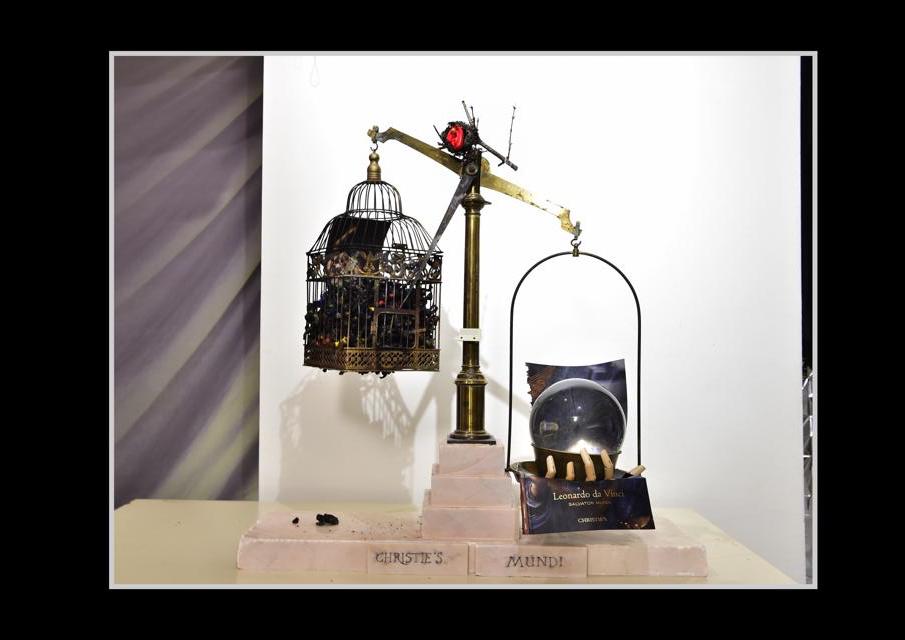
27th April 1972. FRANCO ARIANO was born in Cesena, Italy, but his home has always been Cattolica.
15th of October 2016. Ariano had a surgical operation due to pneumonia that he had ignored and as a result on waking up he returned to life as a Maestro Illuminato, a title that will later be transformed into:
Maestro Illu Minato by Philippe Daverio who, in Florence, created a personally signed work of art for Ariano, which you can see on page 80 of his book titled:
“L’ARTE DI GUARDARE L’ARTE”.
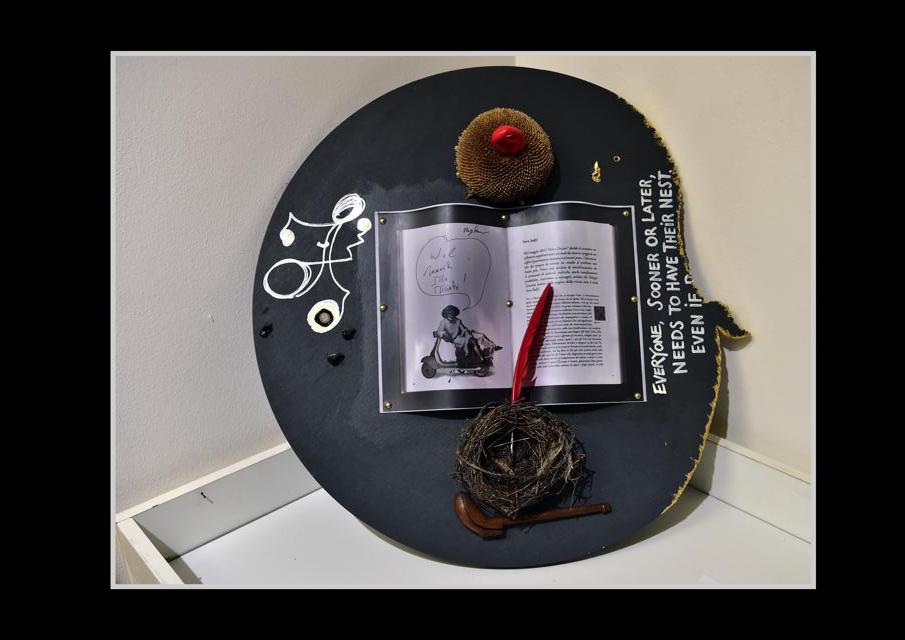
FRANCO ARIANO after that dreadful but equally amazing night, now “SEES” complete and fully formed works of art in his mind, images so clear he has to immediately sketch them down on paper in order to preserve them. If he turns on the light he will lose everything.
Up to august 2018, in less than two years, he had produced more than 1.300 drawings. 200 of these are images that his ”diurnal” logic fails to understand. In essence he doesn’t know what they represent.
FRANCO ARIANO Maestro Illu Minato’ s first work of art is titled:
“IO ODIAVO L’ARTE, fino a ieri 15.10.2016”
(I HATED ART, until yesterday up to 15.10.2016), the day of his surgical anaesthesia,
his second work of art is:
“QUEL CHE TOCCO DIVENTA ORO” - (WHATEVER I TOUCH BECOMES GOLD).
Another peculiarity of his consists in using original CHRISTIE’S and Sotheby’s auction catalogues when carrying out some of his works of art.
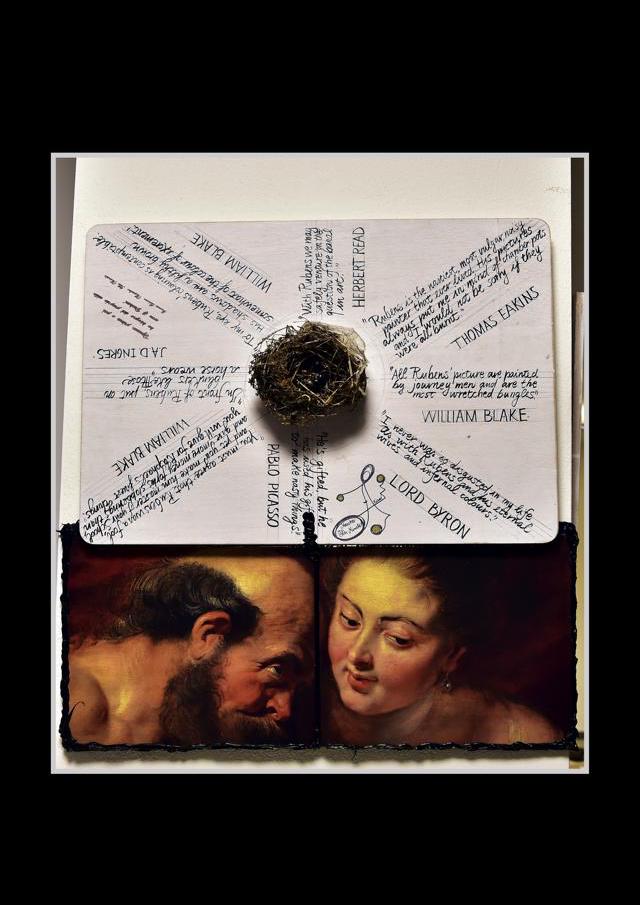
There are three distinctive traits that will enrich all of his work, guaranteeing his recognisability.
The first, fits perfectly with his innate attention to the needs of the weakest, elderly, children, women, animals and artists. In fact he decided to donate to each of his works a real BROKEN NEST (twisted nest, no longer active, collected between trimming and pruning, respecting faunistic laws). The plastic with which the birds have built these nests represents for Ariano the imperfection that characterizes every family or human nest.
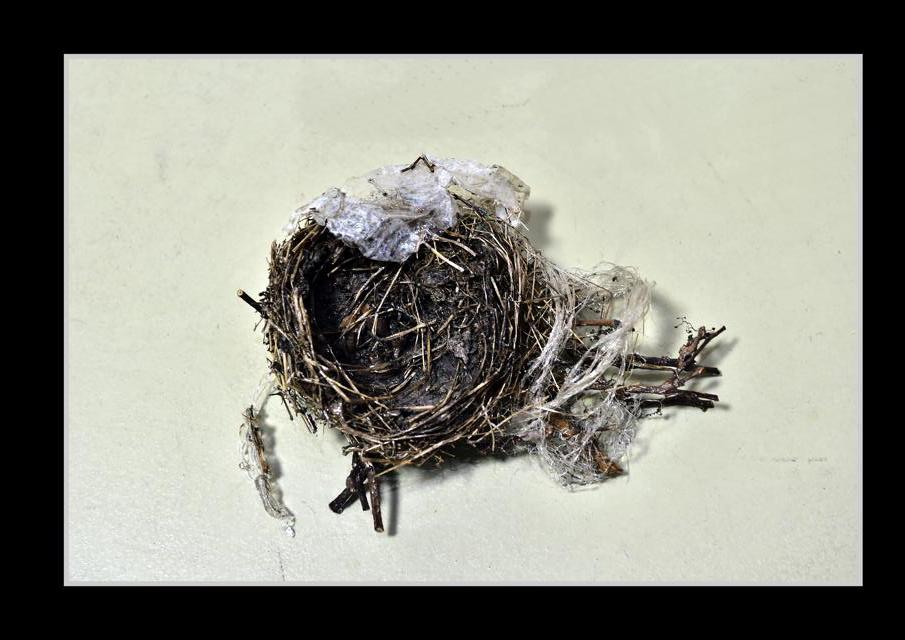
The interpretation of the nest, according to Ariano, is a thought for those who deserve warmth and affection which are rarely or hardly ever received. It symbolizes the hearth of the family, a sort of tree house, a warm, protective, safe place. It is a defensive way of storing our childhood memory, often the only truly peaceful and serene period of our life.
The second, is the attaching of his sentence:
”Everyone, sooner or later, needs to have their nest, even if BROKEN”.
The third, concerns the border that embraces all his work, the frame. It will never be an absolutely linear or perfectly closed limit. Always present, at least on one side of each work, will be an opening created by him through breakage, burns, pieces of frame, cuts and discontinuous traits on the perimeter of each work.
In 2018, during an advanced calligraphy course, held by Concetta Ferrario and inspired by Chinese ideograms, Ariano created his own signature, composed of precise signs and the initials of his name “F ” and “ A ”. It is very coherent and in some parts the shape of the nest is represented. In the execution of the signature he also magically creates an anthropomorphic symbol, consisting of lines and repeated circles at its extremities.
The circle, which has neither beginning nor end, nor direction or orientation, is the symbol of heaven and all that is spiritual. The nest, this sum of repeated circles, brings us back to human concepts of perfection and intangibility. The three steps, on the right of his signature, represent the difficulties of human life which, with commitment and willingness, will be overcome, leading to the desired goal, symbolized by the golden nest.
The large nest at the lower left of his signature, almost elliptical, is a warm and safe place for
Maestro Illu Minato. A thought addressed, in this case, to himself.
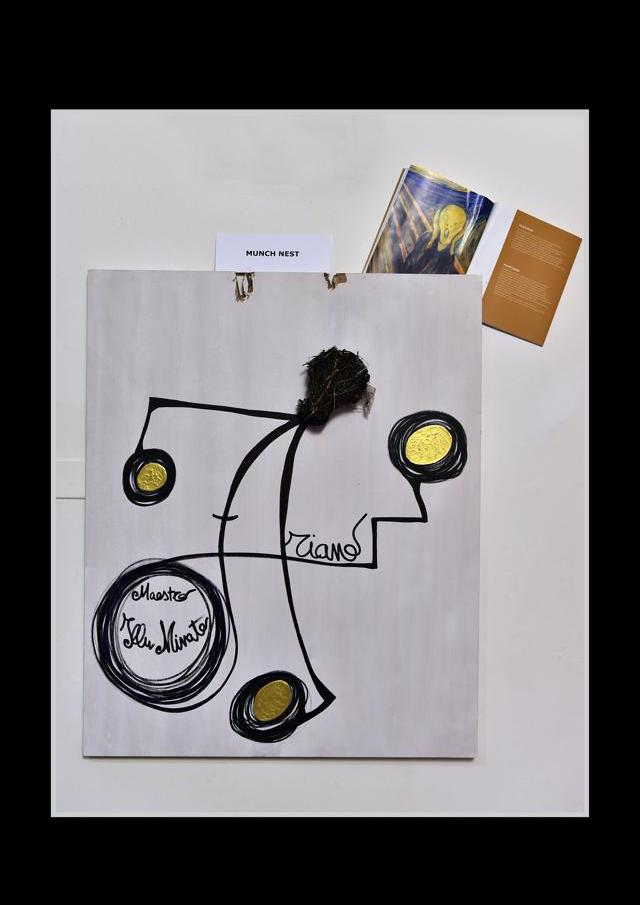
Everything contained within the ”logo” shows his drive and motivation:
“I DON’T WANT TO LEAVE JUST SIMPLE SIGNS, BUT MESSAGES”.
In 2017 Ariano invented a device that allows rivers, seas and lakes to create paintings taking advantage of the diverse characteristics of waves.
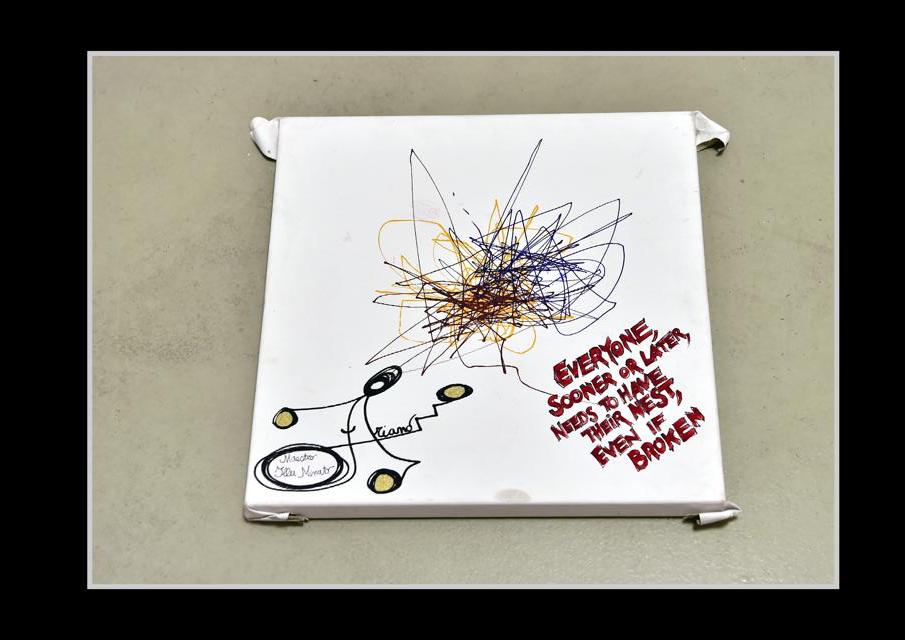
The same year, at Rimini airport, wearing a helmet and fire-resistant clothes, he positioned himself behind the engine of a plane, and by exploiting the fast flow of air coming from the engine, created using acrylic paint, the series of works named “AERO”.
Using the same principles for the MotoGP, Ariano presented a new project for DORNA and DUCATI CORSE. Both were enthusiastic to the fact that, by using this new multiple pipe device filled with paint, a MotoGP could paint a canvas exploiting the power of the air generated by the most powerful motorcycle in the world.
Ariano has the ARROGANCE and AWARENESS of being able to compete with:
“Pablo Diego José Francisco de Paula Juan Nepomuceno María de los Remedios Cipriano de la Santísima Trinidad Martyr Patricio Clito Ruíz y Picasso”,
called Picasso, with whom one has the certainty of the “Sign”,
while with Ariano one has the certainty of the “Message”.
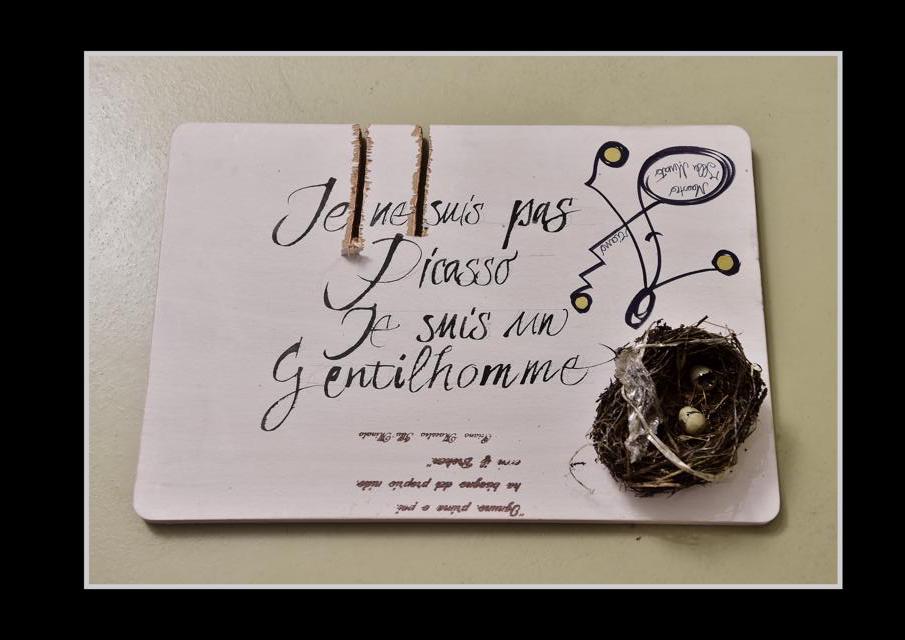
He collaborated with Giovanni Sangalli of Milan in the creation of some paintings, using Fluo paints, which contain ”secret” images, that can only be seen with ultraviolet rays.
Ariano shared his atelier with Federico Signorini, a painter and musician, of whom he says: “thus far he doesn’t know who for, what for, or why he is doing his work of art, but the outcome of his works are magnificent”.
He has always followed his desire to increase his scientific and practical knowledge with the will to enrich his artistic and poetic side. His philosophical development has grown thanks to the friendship of the psychologist and climber Siegfried Stohr, the ”Driver Without Wings”.
To improve in sculpture and “unusual” techniques he attended a laboratory in Montefiore Conca, hosted by Maestro Umberto Corsucci, where he learned: techniques, tenacity and attention to detail. They continuously compared and contrasted each other, almost challenging one another on their mutual creations. At master sculptor Corsucci’s bottega, in Italy, FRANCO ARIANO’s enthusiasm was stimulated, unleashing his passion and giving course to the transformation of this boy born without an artistic education. As in the best fables, however, at some point the values of the two artists clashed and resulted in disagreements. The divergence of views between Ariano and Corsucci, perhaps due to the age difference, increased in intensity and frequency.
As Corsucci said:
”Two cocks can’t remain in the same chicken coop”,
”You are also, Maestro Illu Minato, as cold as the blade of a knife”.
Ariano decided that he was ready to spread his wings, it was time to leave the ”NEST”.
The first time Ariano saw the MoMA and the Tate he had two thoughts,
the first was:
“I WANT TO CLIMB THEM”,
the second:
“I NEED MORE THAN ONE ROOM,
WHAT I REALLY NEED IS AN ENTIRE FLOOR TO DISPLAY MY WORKS”.
His heart filled with joy when he discovered that Van Gogh was also fascinated by bird’s nests. Ariano’s feelings for Vincent Willem are described in the next chapter VAN GOGH.
With a Bird’s Nest sketch, Vincent Willem commented in the same letter of his tender feelings for nests of birds and people:
”When winter comes (when I have more time for it) I shall make more drawings of this kind of thing. “La nichée et les nids” [the nestlings and the nests], I feel deeply for them - especially people’s nests, those huts on the heath and their inhabitants.”
In 1885, he made them the subject of five still lifes in a row. He wrote to his brother Theo that he thought these would appeal to nature lovers, “because of the colours of the moss, dry leaves and grasses, clay &c.”.
Earlier that summer, Vincent Willem had told Theo how he had got the nests. He had gone out with a peasant boy to look for them. They found six, “from which the young had already flown, so that one could take them without too many pangs of conscience”. According to Van Gogh’s friend Anton Kerssemakers, he had ”no less than 30 different birds’ nests” in his studio, collected from his walks or purchased from children for roughly 10 cents per nest. For the more elaborate nests, such as the two ball-shaped wrens’ nests in the top right of the Still Life with Birds’ Nests painting, Van Gogh would pay more”.
Ariano has in his atelier about 1,500 BROKEN NESTS (no longer usable by birds and collected in accordance with the law). He recomposes and sometimes reconstructs these nests from the beginning. Each of them expresses two functions, representing his own signature on each work and offering a warm embrace to its recipient.
From this feeling Ariano dedicated a series of works, titled
”HOMAGES by FRANCO ARIANO Maestro Illu Minato ” to:
Vincent Willem Van Gogh, P. Paul Rubens, Andrew Warhola, Primo Levi, Kurt Cobain, Elvira Vannini, Umberto Corsucci, Edvard Munch, Eric Hebborn, Amedeo Modigliani, Guerrino Bardeggia, Andrea Salvetti, Carlo Cracco, Charles Baudelaire, Madalyn Murray O’Hair, Noura Hussein, Vincenzo Peruggia, Marco Castiglioni, Amy Winehouse, Robin Williams, Enrico ed Alfredo Accatino, Flemish Primitives, Vincenzo Muccioli e San Patrignano, including children and women who have been victims of addiction and violence.
Continuing with this approach, protection of one’s neighbour, he invented systems and works in his own way.
Ariano, always, observes problems by moving away from ”sequential logic”.
He resolves them by discarding obvious considerations, looking for alternative points of view.
Examples of this approach are the inventions of the ERECTUS grape and Wine, the mobile phone spacer and the safe baby pushchair, which avoids the child facing the street, while crossing the road. Using Ariano’s system the handler is in front of the pushchair and no longer behind.
He also created a series of works on “FEMICIDE” and an installation called “PEDREPE”, a diverse meaning of the crib, a critical representation of paedophilia in the church.
Very often he became interpreter of ”lateral thinking” thanks to a simple and ingenious reversal of the order of objects or subjects, as in the work for the A.S.P. UNESCO project entitled ”FRANCESCA e Paolo”.
From a very early age Ariano is in love with both matter and materials, he keeps everything he experiments on and creates. He is fascinated by water and earth, plants, animals, nests and burrows. Already at the age of 13 he is able to disassemble, improve and reassemble a two-stroke engine, while also being able to design and build wooden stairs.
He has only one goal in mind: to improve himself and everything he comes across.
This attitude also leads him to help a few World Motogp riders who, once they start to embrace his philosophy, personally verify that it is possible to change for the better.
While visiting Fabrizio Pecci’s ostrich nursery, in 1996 he saw a little ostrich which is unable to walk, surrounded by other ostriches slowly pecking it to death. Ariano asked Mr. Pecci if he could take the bird in order to save it. After six months of training the baby ostrich, on a tailor made walking trolley Ariano had built, the little ostrich “Pigi” started to walk normally and you can now find it at the Falconara zoo.
His passion for viticulture took him to plant a vineyard in the Maldives as well as one in Livigno. Moreover and he carried out a series of works of art called “VITIS DOMINI” in Italy.
He dominated the growth of Vitis vigour, uninterruptedly for 6 months, providing them with special frames within which the vines can grow and spread.
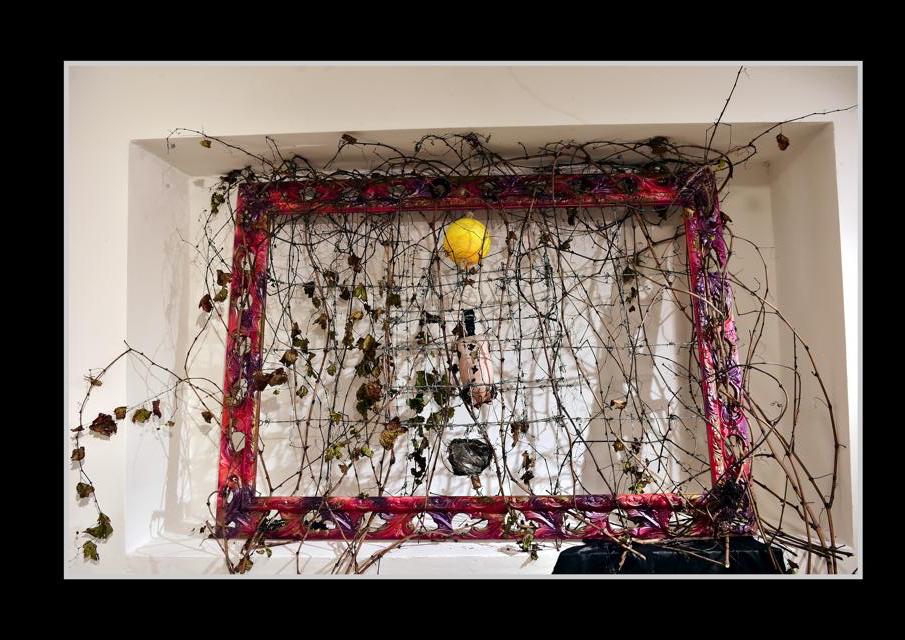
In Siena, 2003 as a wine collector, during a viticulture course held by Dr. Ruggero Mazzilli entitled “Respecting the demand for verticality of the vascular structure of the vine” Ariano invented Vino ERECTUS, while sitting on the last chair at the last desk.
In 2009 he decided that all the bottles of Erectus wine had to be:
1. in special glass, with the neck of the bottle at least 10 cm long, to house the 2 corks (he carried out this work in collaboration with the bottle maker Vetreria Etrusca).
2. Closed with two corks.
3. Corked by of a manual corking machine capable of introducing the 2 corks into the bottle neck (a Swiss company transformed a bouchones of Champagne bottles for him).
4. Equipped with a special elongated
corkscrew, created in brass in Pordenone.
5. Sealed with lacquer wax.
6. Individually stamped with sequential numbers.
7. Placed individually, inside special safes in metal or marble, for better
aging.
The solutions to these 7 technical aspects are best described in the Vino ERECTUS chapter.
In 2011, CHRISTIE’s in Geneva auctioned the first safe containing the No. 1 bottle of his first 2009 vintage, this vintage year also marks the birth of his son Benjamin.
The auction made history with the highest price ever paid for a first vintage wine bottle and articles appeared in 52 different publications throughout the world.
In november 2018, with the patronage of Cattolica Council, Ariano created his first personal exhibition titled:
“EVERYONE, SOONER OR LATER, NEEDS TO HAVE THEIR NEST, EVEN IF BROKEN”.
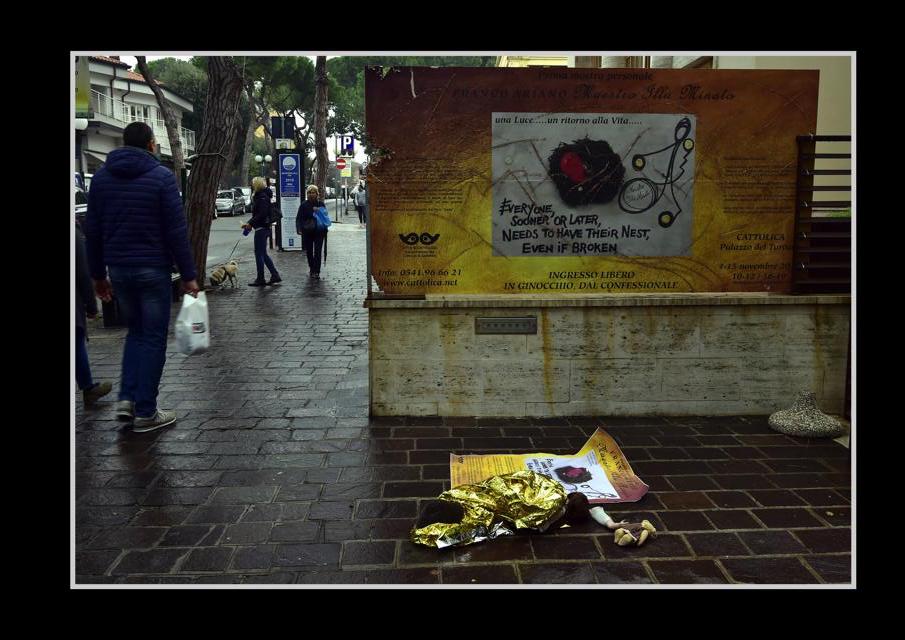
“Captivating, provocative and upsetting.
Designed to leave you breathless, to reflect on the world around us from innovative angles, starting from our deepest roots, to ”land” to the pillars of modern art and culture, in particular to Vincent Willem Van Gogh.
An incredible journey awaits you with eyes focused on our society, its ironies, contradictions and injustices, revolutionizing the end in every scheme and preconception, coming to a great truth: to return each one to their nest, even if BROKEN”.
FRANCO ARIANO Maestro Illu Minato , a LIGHT.. ... a return to LIFE.....
Entrance was free, but he decided that visitors could only enter the exhibition by crawling on their hands and knees through a small hole that he had made inside a deconsecrated confessional.
He was asking people to break down, without hesitation, their preconceptions towards the newly proposed messages in the exhibited works. He put into question, from the outset, the mental patterns and the defences of the visitors willing them to accept this particular psychological challenge.
In essence he transformed adults into children, re-introducing them to primeval actions and to the proximity and relationship with the Earth.
From the beginning Ariano, well aware of the value of his works, designed an archived for the cataloguing of them.
He respected and followed the rules of UNESCO in cataloguing.
“The archives retain testimony of the decisions taken, the actions carried out and the memories accumulated.
The archives constitute a unique and irreplaceable heritage, transmitted from generation to generation.
Archival documents are managed since their creation so as to preserve their value and meaning.
They are reliable sources of information for a responsible and transparent administration.
They play an essential role in the development of societies, contributing to the establishment and preservation of individual and collective memory.
Access to archives enriches our knowledge of human society, promotes democracy, protects citizens’ rights and improves the quality of life”.
Thus reads the incipit of the Universal Declaration on the Archives,
written by the International Council of Archives and adopted by UNESCO on November 10th, 2011.
REJECTED
Franco Ariano Maestro Illu Minato
This sequence of success is preceded by a large number of negative events, interpreted by FRANCO ARIANO as single bricks, placed one on top of the other, creating the work
”LA TORRE DEI NO” (THE TOWER OF NO).
Dedicated to the theme of ”NO” the artist also created the work ”E’ PEGGIO UN SI SBAGLIATO DI UN NO GIUSTO” - ”WHAT IS WORSE a worthless YES or an honest NO” in homage to the sentence spoken by Mara Maionchi during XFACTOR Italy 2018.
Before October 15th, 2016, in reality 2015, Ariano wanted to exhibit the ERECTUS safe and its bottle during the future EXPO 2015 in Milan to its many millions of visitors.
He asked various ministries from the Italian Government, the Emilia Romagna region, the province of Rimini and a dozen other institutions connected to the organization of the event concerning the nutrition of the planet and food. There were many promises received and reassurances, but in the end they did not find those 50 square centimetres needed to support that particular wine.
He thought that on such a platform for ideas, experiences and stimuli, a stage able to host thousands of events in only six months with reviews on cultures and peoples around the world, there had to be a place for that safe. But there was NOT.
Up to the beginning of 2017 Ariano had not created even one of the many works that he had drawn during the previous nights. However, he feels that these future works will be of great social value and he has the great desire to share his philosophy, feelings and technical aspects with curators and managers of the various departments of the most important museums in the world. He would like to talk to curators without any technological or digital filters. He is looking for a peer to peer interview, on the same human level. It’s a mistake to think like this, though.
Because ”MANDA UNA MAIL”, in Italy, and ”SEND AN EMAIL”, from abroad, were the only replies he ever received from beings who call themselves ”human”.
And these two sentences will also become two of his works of art in homage to the thousands of misunderstood artists, especially those not listened to, who wander, like abandoned dogs, around the closed doors of art galleries.
At that time Ariano presented himself to the Tate Modern in London to give his thoughts on the origins of his future work. The reply”: If you don’t have a dealer, we can’t talk to you”.
“Please send an email”.
He then tried at the door of the Gagosian Gallery in London and after repeated attempts, he managed to enter the hall, escorted by the bodyguards protecting the works of Picasso, but he received another “Please send an email”.
He didn’t give in and tried the White Cube Gallery which had kindly invited him to visit the current exhibition and thereafter had asked to see his work.
Ariano replied that they were all still in his mind, but to allow them to understand his style, he gave as an example the device he had invented which allows the sea to create a painting.
The assistant was very impressed and as always invited Ariano to “Please send an email” and ”when you have finished your works come back to us”.
He offered some of his works, in collaboration with the children from schools participating in the A.S.P. UNESCO project, at the MoMA in New York, for the Future exhibition ” BROKEN Nature” at the Triennale of Milan.
REJECTED, although the works had a great social and economic value and were all enriched by BROKEN Nests, in full coherence with the theme of the event. In addition, the energy production system represented by the work titled ”CANNE” (PIPES) addressed the fundamental question of the exhibition, which was how future architects could improve our world.
Back in Italy, he visited Milan more often, where he says
“A MILANO NON CAMMINO, IO VOLO” (IN MILAN I DON’T WALK, I FLY).
Visiting the exhibition ”LOVE” at La Permanente in Milan, Ariano was thrown out due to a misunderstanding. In a section of the exhibition the curators had created 2 parallel walls, on which anyone who wished to, could leave their message on the theme of love.
Ariano overcome by a creative impulse, which in Milan strangely manifests itself even during the day, decided that the two separate gallery walls, must be united by LOVE.
Therefore, unlike all the thousands of notes left by previous visitors, he decided to symbolically unite the two walls with a love inscription starting from one wall, continuing along the floor and finishing on the other wall. The inscription read:
”Love is the energy of minds. FRANCO ARIANO Maestro Illu Minato”.
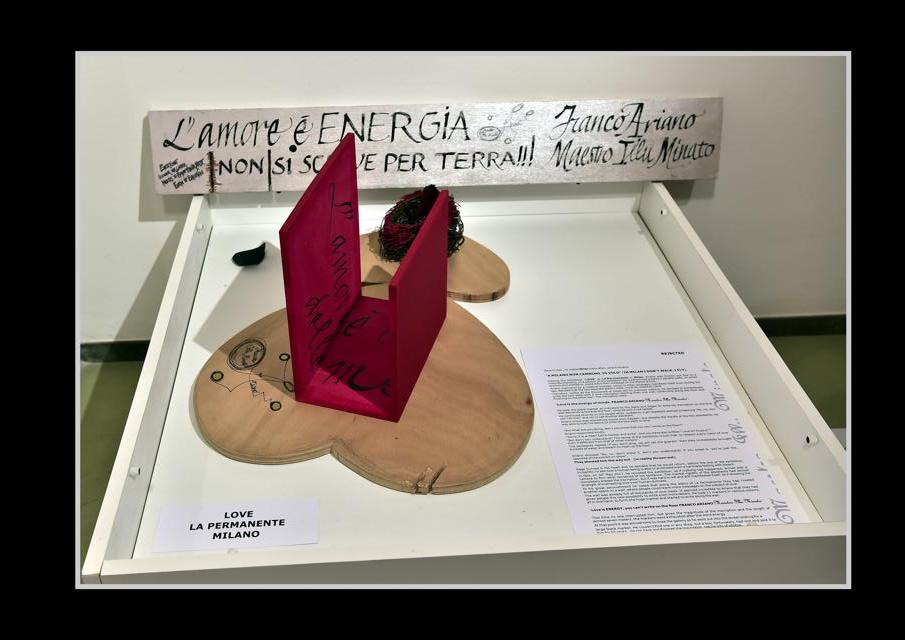
He took the black marker as indicated by the signs and began to write his inscription on the first wall descending towards the floor, covered with a red carpet.
He continued to write on the carpet when, suddenly, a girl assistant started screaming ”No, no, you can’t do that” and ran to call another assistant.
Ariano knew that something would soon happen, but despite the insults of the two assistants, he was able to fulfil his desire to unite the two walls in time.
”But what are you doing, don’t you know that you can’t write on the floor?”
Ariano responded kindly:
“Sorry, it is written“Get a marker and write”. and you have also written “Love Is? Draw it ””.
“But don’t you understand? The sense of the exhibition is just that, to respect every vision of love even if different from that of other visitors”.
The assistants replied ”if you don’t stop, we will call the guards!” then they immediately brought buckets of water and bleach to clean up the floor.
Ariano shouted ”No, no, don’t erase it, don’t you understand? If you erase it, you’re just the opposite of the exhibit on show”.
They showed him the way out. (in reality thrown out).
Rage burned in his heart and he decided that he would return, before the end of the exhibition, incognito, to see how a human being is able to annihilate even a harmless feeling with bleach.
In fact, on 30th May 2017, he revisited the exhibition, as if nothing had happened, armed with a camera to film what remained of his sentence. The mental rigidity of the assistants had almost completely erased the inscription, but it was hard to kill and still manifested itself, as if showing the strength of everlasting love over human dullness.
To his great astonishment he noted that along the stairs of La Permanente they had created another space on a wall, where people could leave more messages on the subject of love.
The wall was already full of thousands of love notes. It seemed incredible to Ariano that they had given people this new possibility to write even more letters. He took 11 markers in various colours, all in one hand, to form one huge marker and started to write along the wall:
”Love is ENERGY, you can’t write on the floor FRANCO ARIANO Maestro Illu Minato ”.
This time no one interrupted him, but given the magnitude of the inscription and the length of almost seven meters, the markers were exhausted after the word energy.
At that point it was almost time to close the gallery so he went out into the street looking for a
large black marker. He couldn’t find one in any shop, but a boy, fortunately, had one and sold it to him for 50 cents. He ran back and finished the inscription, taking lots of photos.
Again in Milan, while visiting an exhibition by Vasilij Kandinsky at the Mudec, Ariano was filming some of the paintings. At a certain point an assistant tapped him on the shoulder saying ”You can’t film. You can only film with an Ipad or with a cellphone, not with a camera”.
He decided to leave.
But before leaving he went into the museum shop on the ground floor. While walking between objects and the works of art on sale he was strangely captured by a leaning golden egg. He felt the presence of something superior, almost spiritual and immediately asked the salesman who the creator of the egg was. He replied “Andrea Salvetti”.
And “Who is Salvetti?” Ariano asked.
The shop assistant explained to Ariano that “Salvetti is a great artist with great sensitivity”. Ariano then asked the assistant to place a yellow post it written in black with the words
“Andrea Salvetti Microcosm”, under the golden egg.
Ariano took a photo to remember the details. But it wasn’t enough. Ariano wanted the egg, he wanted to buy it immediately. However before selling it, the store wanted a Certificate of Authenticity from Salvetti. A price was agreed and the manager of the shop said he would call Ariano after talking to Salvetti.
That same night Ariano felt the need to find out more information about the artist to better understand his soul. Ariano typed the words Andrea, then Salvetti, into Google, then pressed enter. The result: ”Art and Gastronomy in mourning for Andrea Salvetti”, Ariano immediately thought there was some mistake.
He immediately tried again, result:
”Andrea Salvetti has died. Designer and gastronomist friend of the chefs and lover of the Earth ”.
The hairs on the back of his arms and neck rose, there was a lump in his throat, Ariano was confused. He felt he “had been sent” a message from the spirit of the artist, deceased exactly the day before.
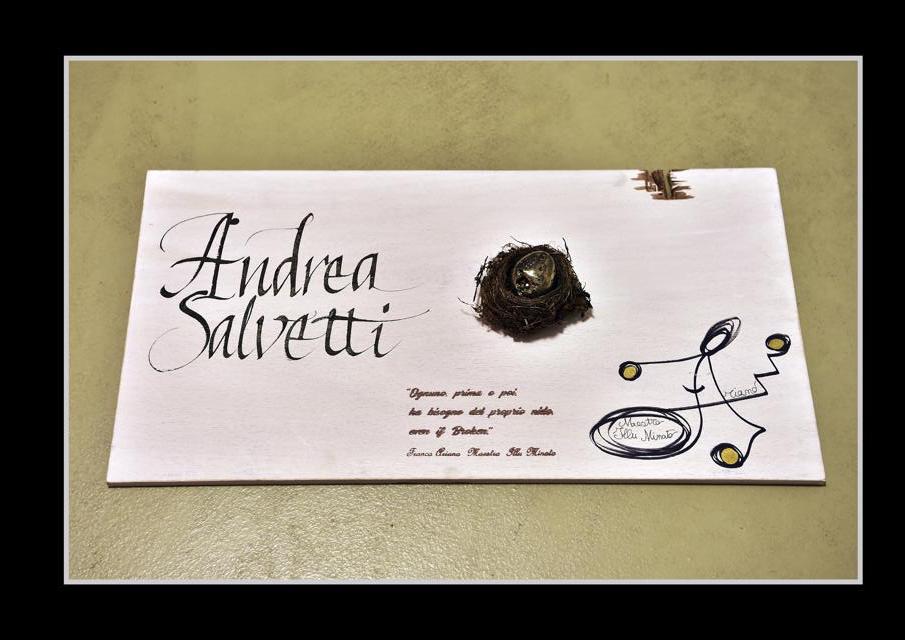
This sequence of ”NO” sees him as the protagonist in another situation.
On the recommendation of the photographer Duilio Piaggesi, who is an admirer of FRANCO ARIANO’s work, the artist tried repeatedly, as usual without any reply, to contact the press office of Pirelli Hangar Bicocca in Milan.
After many ”SEND AN EMAIL” and several attempts he managed to speak, just once, by phone to a manager who immediately answered ”We are busy until 2020”, it was now 2018.
Ariano attempted to explain that he only wanted to speak to the art director for 5 minutes, but she said it was impossible.
He decided, since he was already in Milan to go to the Hangar, but first he phoned to ask if the manager was present, the reply ”she is absent”, Ariano went anyway.
At the exhibition office he asked to speak to the same manager. The girls at the desk asked him, ”Are you the reporter from the Repubblica?”
Ariano should have said ”NO, I am the artist who has invented a particular “Tree of life” to compete with that of Klimt and due to its immense size, I really need one of your spaces”,
but he heard the word “YES” coming from his mouth.
30 seconds later the previously absent manager was standing in front of him.
At that point, Ariano introduced himself and asked if he could speak to the artistic director.
”Impossible, but I invite you to enjoy the Lucio Fontana exhibition on show right now”.
He thanked her and was able to ”experience” the works conceived by Fontana, a true genius.
GILLO DORFLES
Franco Ariano Maestro Illu Minato
There is one unique “NO”, above all, that made Ariano suffer the most.
It was the NEVER received ”NO” from Gillo Dorfles. Ariano had long followed the work of Dorfles, first as an artist, then as a connoisseur of aesthetics, writer and art critic.
At the Triennale of Milan, Ariano had seen an exhibition staged by Dorfles when he was 106 years old!!
He wanted to ask him, “you have reached the age of 107 years old, so for you what is the meaning of life?” (Ariano’s interest was linked to the tree of life he was working on).
In November 2017 he plucked up the courage and phoned the home of Dorfles asking for a personal appointment with the professor. A very courteous lady responded saying that he was 107 years old and very ill, so it would be better to phone again in December.
A month passed and before Christmas Ariano phoned again explaining to the lady that he would like to have some advice from Prof. Dorfles on a work he was creating, the Tree of life proposed to the Pirelli hangar Bicocca. The lady, very kindly said The Professor had deteriorated and was receiving oxygen from oxygen cylinders. She asked Ariano to call her back in January 2018.
In mid-January the lady replied that Gillo was still attached to the oxygen tanks and he now had short memory loss. A meeting would have been useless, as well as heartless. Ariano at that time recalled the worst moment of his life, where, just 1 year before, he had been attached to oxygen tanks during the time he had neglected his own pneumonia.
A few nights later Ariano dreamed that Gillo Dorfles would have certainly liked his idea. He imagined his Tree of life created in collaboration with Dorfles, who at the moment of his death, had donated his oxygen cylinders for the trunk of the Tree.
This work of art served to focus the attention on the importance of the quality of the air.
Ariano understood that death would come soon and explained to the lady about his dream. He asked if she had anything against donating the oxygen cylinders, that no longer served any purpose, to the trunk of Ariano’s Tree of life. She was very positive and encouraging. In fact, in this way, Dorfles would become the first artist to participate in a work of art after his death.
The lady replied that in her opinion there would be no problem, but not being her decision she invited him to call the heir of Dorfles. In February 2018 Ariano called him explaining the project, but Ariano immediately understood that the other side did not understand neither the motivations nor purpose of the work.
Ariano thanked him, accepted this new “NO”, never received from the real owner and decided anyway, to create his Tree in his own way, but above all......
On March 2nd, 2018, Professor Angelo Eugenio Dorfles died. Perhaps his soul transformed into the ghost and hero named VITRIOL, placed in the midst of figuration and literature, which Dorfles re-invented at 106 years of age.
The acrostic V.I.T.R.I.O.L. is emblematic of the aim of the Alchemist:
”Visit Interiora terrae, rectification, invenies occultum Lapidem”.
The invitation, addressed to the inner Being-Earth of everyone, is the following: ”Visit the interior of the Earth, and changing (with successive purification) you will find the hidden stone (which is the real medicine)”.
Behind vitriol (sometimes represented by King Duenech) there is on one hand the procedure to arrive at the completion of the Opus that can only start from the mineral inside the earth.
On the other hand, there is a kind of invitation to investigate one’s soul to purify itself which is a process parallel to that of the production of the Philosopher’s Stone.
VAN GOGH
Franco Ariano Maestro Illu Minato
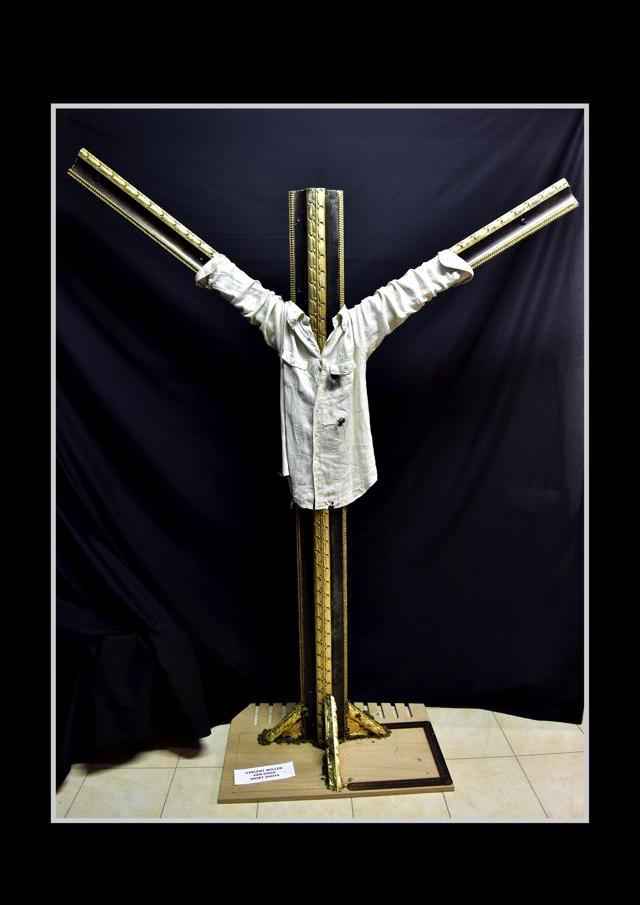
In August 2018, Ariano told Dr. Massimo Piscaglia of Pesaro of his intention to visit the Vincent Willem Van Gogh MUSEUM and the Pipe Museum in Amsterdam.
He needed to study the details of the Dutch artist’s work.
He was hungry for finer points, details and nuances as he intended to create 31 different homages to the works in which Vincent Willem had depicted the pipe in his 6 self-portraits and other paintings. The pipe was the object which allowed him to enjoy those very rare moments of serenity during an extremely painful life.
Dr. Piscaglia pointed out to Ariano that his son, Giovanni Piscaglia, was the director who had made the latest Van Gogh film titled ”Van Gogh between wheat and sky”.
Ariano was amazed and warmly complimented him on this fact. The doctor advised him to enhance his research by also visiting the Otterlo Kröller-Müller Museum, Vincent Willem’s second home. With almost 90 paintings and more than 180 drawings, the museum possesses the second largest collection in the world of Van Gogh’s works.
Ariano set off on the most fascinating journey of his life, made even more special because he was also travelling with his son Benjamin and his wife Milena.
FIRST STOP: Otterlo, the Netherlands.
He wrote down many notes and recorded various details and discovered that 2 paintings with nests were present at the Kröller-Müller Museum. He had also the opportunity to finally see some of the works of Jan Fabre, an artist who Ariano had admired for a long time.
The best thing about the trip though was still to happen. On the way back while walking between the hedges of Otterlo he found a BROKEN Nest on the ground, an old unused nest that had fallen from a tree.
He picked it up and immediately understood that fate had once more knocked on his door. Looking at it he immediately compared it to the other 1,500 BROKEN Nests he had at his atelier. He realized he had a true masterpiece of nature in his hands. The nest had a diagonal shape, it was different, elongated, voluminous and covered with moss.
One characteristic unified it to his other nests, it also had ”human” material in it, too, not plastic this time, like the others. In fact there was no plastic scattered along the streets of Otterlo, the only material the bird had taken was some used white tissue paper, placed in the upper part of the nest.
Compared to the others it was also much heavier, so the bird that had built it had cleverly placed earth and clay inside the nest.
Why? Ariano continued to ask himself this question:
who or what had taught birds how and where to build a so perfect, durable work of engineering without hands?
No other nest in his possession was so ”imperfectly” beautiful. Not only beautiful, but undoubtedly the most beautiful of all, almost on a par with the one used in the work ”SVEGLIA”, for the A.S.P. UNESCO project, using real “slices” of a book by Carlo Cracco.
But then a problem arose. How to take it back to Italy? He did not want to hide it from the customs control at the airport and decided to be as transparent as possible. He put it into a container taking care to protect each side of the nest before boarding the plane.
SECOND STAGE: The Van Gogh Museum in Amsterdam.
Because of his excitement and a thousand other commitments he had forgotten to book the tickets to the museum on line and the booking office informed him that there was no more availability. He was also told that even for the Anne Frank Museum there was only availability 3 months ahead. Therefore, there was no alternative, he would have to try again on his next trip.
It was unbelievable, he had arranged the trip to the Museum and he could not see the exhibition. No! If it were to be like this, he wanted the people in the booking office to tell him to his face why there were no tickets. So he went to the museum and to his surprise he found a queue, albeit a kilometre long, which he hoped, perhaps at its end there would be some tickets available. Yes, incredible as it may seem, he didn’t know how or why, but he was finally inside the museum.
Letters, sketches, frames, pictures, stories and research. Everything he had studied in dozens of books was finally all there.
Not copies or prints, not art according to the absurd idea of tino sehgal.
The “originals” were only 50 cm from his eyes, eyes swollen with tears of joy, as he looked at them from above and below, from both sides, repeatedly approaching and moving away, able to see what was impossible to see in books, the soul of the colour perfectly inserted into the soul of the matter, which, when you sense it, ”You feel as if in heaven.”
He was so passionate about the whole experience that something unexpected happened:
..... ... ......... !! (This cannot be written)
THE THIRD AND FINAL STAGE: The Pipe museum in Amsterdam.
Ser Jacopo from Pesaro made an appointment for Ariano to meet the director of the museum.
Ariano wanted the director to better analyse the works in which Vincent Willem had painted the pipes. Ser Jacopo had created a lot of pipes, a reinterpretation using new materials and shapes, dedicated to the works of Van Gogh.
One by one, they analysed the paintings of Vincent Willem. The director gave Ariano technical and helpful evidence together with social insights regarding each of the pipes depicted. In fact Ariano was very fortunate because this same museum had already done a similar study in 2015.
It was at that time when a new discovery was made about the painting:
”Still Life with figurative jug, coffee grinder and pipe”.
The director told Ariano, that what everyone had thought previously was a clay pipe, was actually a wooden pipe holder.
This discovery was fundamental to the accuracy Ariano intended to express in his 31 future works.
The trip ended in the best way. After the strict checks, even bodily, the Dutch airport customs control had nothing to complain about, especially during the inspection of the Otterlo nest, and we were allowed to continue our journey home.
HOMAGES TO VINCENT WILLEM VAN GOGH
Ariano created 31 homages to Vincent Willem Van Gogh. He also modeled and replicated in series his left ear, colouring it in red and gold, to give it to the memory of the Dutch artist.
The first work was ”I adore the soul of Vincent Willem Van Gogh”; the second ” Between wheat and sky”; 25 were creations on many panels of marine plywood and 4 are linen shirts, on to which he shot several gunshots.
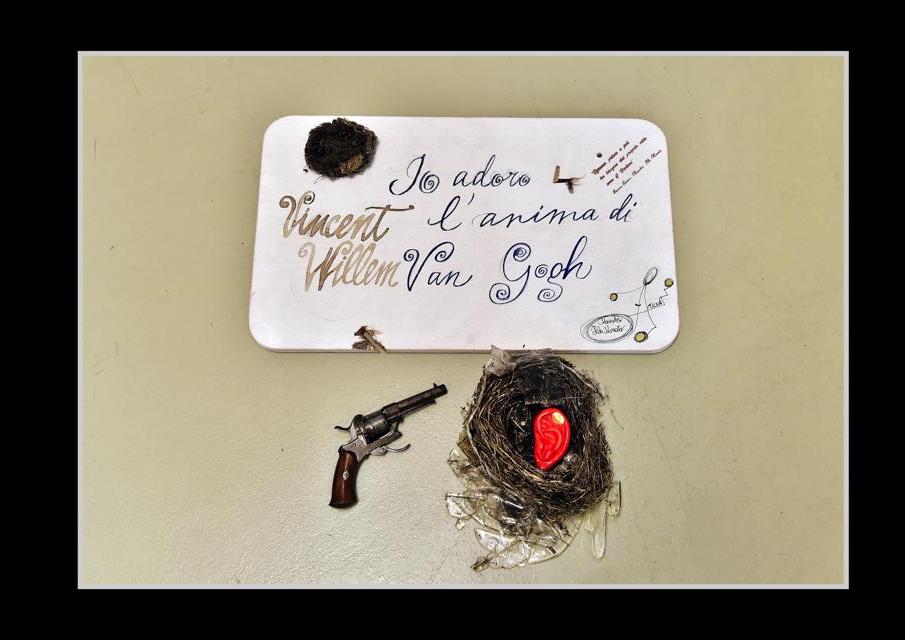
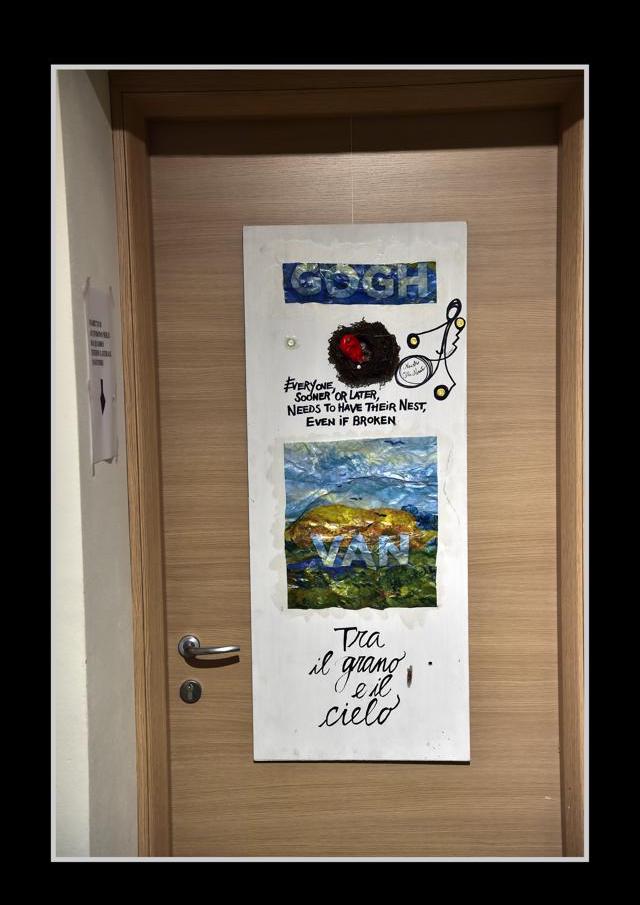
His purpose was to put doubt on the circumstances that had led to the epilogue of Vincent Willem’s life. Ariano asked a certified arms officer to shoot two rounds onto each of his 31 homages.
Ariano chose a very similar gun to that which is believed to have been the gun that killed Vincent Willem Van Gogh. The weapon was typical of the time: a 7mm pinfire pocket revolver, known as a pistolet à broche, designed and manufactured by Casimir Lefaucheux.
62 shots, up close, from afar, from different angles were fired.
These shots plus other shots, fired at 4 different linen shirts, placed on a dummy, are collected in an incredible video created by Ariano:
“HAPPY VAN GOGH by FRANCO ARIANO Maestro Illu Minato”.
Considering that there is no evidence on the remains of the garments of Vincent Willem and the bullet that killed him did not exit his body, but was wedged in one of his ribs, Ariano shows that it is OBJECTIVELY impossible to determine whether the dutch artist committed suicide or was killed.
In fact many shots exited the wooden panel and some remained in them, exactly as it happened to Vincent Willem Van Gogh.
Ariano bought maniacally objects and materials consistent with the era in which Vincent Willem lived from all over the world. Original coins, Dutch cents in silver, from 1878 to 1885 representing the period in which he painted the works with nests, nests he paid many cents for.
In addition it bought original wooden pipe containers, original parts of the gun lefaucheux, shells of 7mm bullets, dried and ruined sunflowers, just as they liked to Vincent Willem, BROKEN NESTS, several pipes, old razors, ANTIQUE handkerchiefs, blu vines, absinthe seeds, Remembrances of Woman. All them were attached by Ariano to the panels of marine plywood and to the linen shirts, all previously affected by 2 gunshots with 2 different angles.
All the panels, in their left side, were cut faithfully following the document in which a sketch, made by the Doctor who medicated Van Gogh’s wound to the hospital, Dr. Félix Rey.
On August 18th, 1930, Vincent Willem Van Gogh’s doctor drafted a small, unassuming note describing the artist’s severed ear. Over the next 86 years, the note traveled from its home in Arles, France, to the United States with author Irving Stone and eventually to The Bancroft Library in Berkeley.
The design was exhibited in the exhibition ”On The Verge of Insanity” dedicated to the artist’s folly at the Van Gogh Museum in Amsterdam.
IN THE SKETCH YOU CAN CLEARLY SEE THAT:
THE CUT IS ABOUT MOST OF THE LEFT EAR.
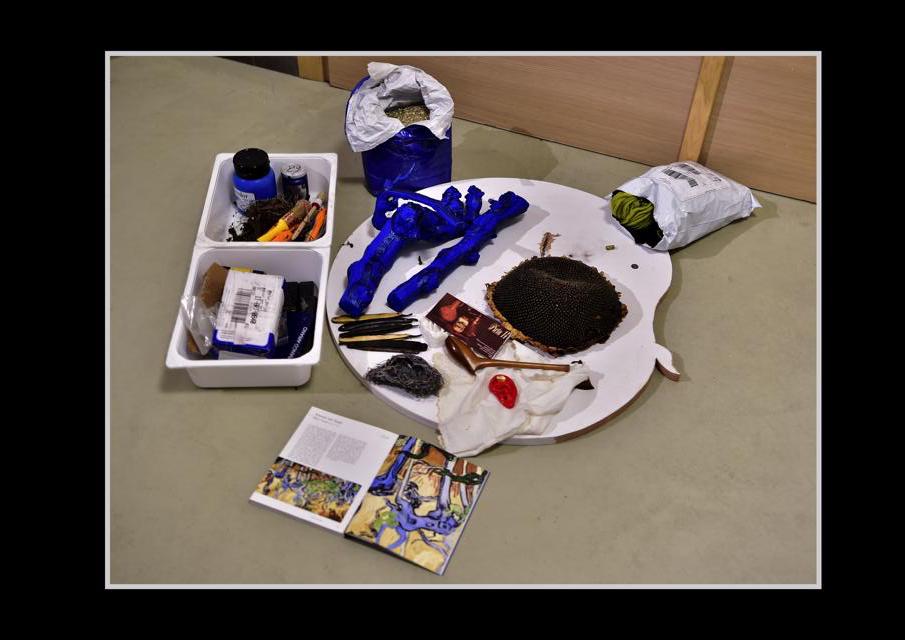
NATURE & CHILDHOOD
Franco Ariano Maestro Illu Minato
Romagna, Tuscany, Salento and Switzerland are the places of Franco Ariano.
FRANCO ARIANO has lived in Cattolica since childhood and knows and understands the human connection to the sea, to the ports and boats.
He has studied seafarers, captains, sailors and the few master caulkers still alive today. When he looks at the horizon, he always sees the sweet promontory of Gabicce Monte, full of hilly climbs and descents surrounded by gorse and maritime pines.
He also spent his childhood with his nearby grandparents, between Cesena (Romagna) and Porto Cesareo (Salento).
In Romagna he learnt about the rural characteristics, attracted by nature, the chickens and chicks, diving into a sea of wheat grain and caressing the soft fur of rabbits. He ate his grandma’s Piadina and strawberries and fresh raw eggs, opened by beating them gently against a wall.
Every morning he rose with only one thing on his mind, to go to PIA’s farm, a peasant woman who lived across from grandma, to see if her hens had laid any eggs. But the nest boxes were too high for a young boy and were obscured by a wooden plank, so the only way to find out if there were any eggs was to climb-up. From this experience the work ”C’E’ O NON C’E’?” (IS IT THERE OR ISN’T IT THERE?) was born.
In Salento he enjoyed the beautiful sea colours reflected by the sunset. He visited his grandfather’s vineyard and pricked his finger on a prickly pear while pruning olive trees.
In Salento the earth is a beautiful rusty-red colour that contrasts with the white of the stone below. In the countryside, to shelter from the sun, it was usual to take a break inside an ancient Trullo, Ariano later discovered that the same was true in the small vineyards of Burgundy. Only when the temperature exceeded 40 degrees did he understand that someone should invent a new word, because the word ”thirst” is not enough to describe the primordial need of clean, fresh drinking water, which today we too hurriedly underestimate. From these thoughts perhaps the work titled ”MIRACQUOLO”, created for UNESCO, originated.
From a distance Ariano understood that the sea towers had been erected so that each had a clear view of the other. Salento was also the place where he discovered an underwater world and the experience of pressure on the human body, for the first time. He observed morays, sea urchins, octopus, scorpion fish, crabs, eels, shrimps, sharks, sea bream, dolphins, tuna and fish with colourful stripes that influenced and stimulated his imagination not only for beauty, but because the locals called them ”KING’S COCKS”.
He learned fishing techniques, with a rod, net, and “BOCCACCIO”, a glass vase covered with a piece of white cotton, with a small hole in it, over the entrance to the vase. He rubbed some flour or cheese onto the cotton cloth and immersed the vase in the water and left it there.
A few minutes later the fish, attracted by the food, entered through the hole and remained inside the vase which was then pulled up by the young child. What satisfaction.
Under the water he saw some striped fish, ”Casciole” in dialect or “Rigatini” in italian, which had peculiar behaviour. They were attracted by the clouds of sand created by the movement of his little feet. This gave him the idea of inventing a new way of catching fish. He placed a small net on the sandy bed, then moved his feet quickly and a lot of fish arrived almost immediately. A that point he pulled-up the cords connected to the net and ”voilà”, fresh fish for everyone. However, with mugil and mullet it didn’t work, although it was still wonderful to have succeeded.
He was surrounded by natural forms, landscapes and values that we can often find in his works. For Ariano the proximity of nature is a continuous inspiration.
His focus on living forms improves his ability to observe and to provide models for his works.
WORKS UNESCO ASP
Franco Ariano Maestro Illu Minato
In 2017 Ariano was chosen by UNESCO, Rome, together with I. C. G. Zavalloni, Riccione, to become part of the national Unesco network ASP.net. 2017/2018, presenting his artistic project titled “ INTERNATIONAL ART AND GOALS FOR” UNESCO AGENDA 2030” to the UNESCO commission that welcomed his work with great interest.
His creations are related to the goals and objectives of the UNESCO AGENDA 2030 for sustainable development interlinked to the protection of human rights and cultural diversity, having the highest human and educational value.
Ariano’s ambition is to obtain recognition for his works as “BEST PRACTICES” even from the Paris UNESCO Commission and to exhibit his works in the most important museums.
CANNE - PIPES
Work inspired by goal # 7 OF AGENDA UNESCO 2030:
Ensure access to affordable, reliable, sustainable and modern energy for all.
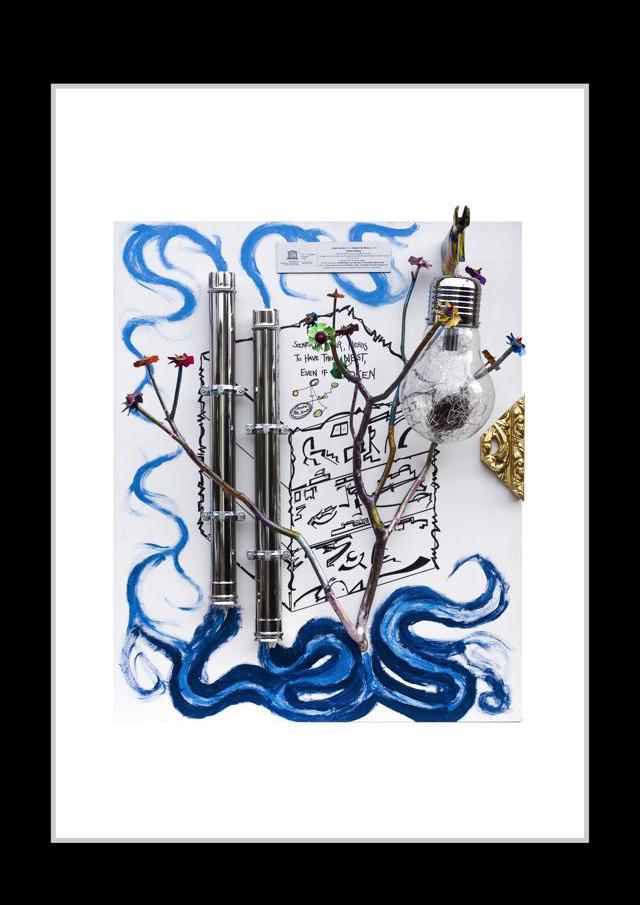
The artist, in this case the inventor too, observed that every house, apartment or block of flats have at least one pipe for boiler or chimney smoke discharge.
The pipes are about 6 to 12 meters high, and about 20 to 100 meters in the blocks of flats.
The air inside of pipes moves continuously from bottom to top and in some cases from top to bottom.
What makes this phenomenon possible is the thermal differential between the air inlet and outlet.
If we insert, inside the pipes, some very light fans connected to energy accumulators, we could have free and clean energy for everyone.
In addition we would have a greater energy yield if we:
- increase the number of pipes per house,
- lengthen them in height,
- reduce their diameter at the exit point,
- bury part of the pipe at least 3 meters under the ground,
- use dual direction type fans,
- paint the warmest parts of the pipe (the parts in contact with the sun’s rays) black.
This work of art is a wooden panel on to which two steel pipes have been positioned on one side of a painted block of flats.
On the other side there is a tree with clusters of small coloured fans. These small fans when inserted inside the pipes produce energy due to the natural air displacement and so the fans power the large glass bulb.
The nest, as always, is present signifying a work of art created by Ariano.
This time it can be found inside the large bulb, receiving heat and energy from the previously described system.
EDU
Work inspired by goal # 4 OF AGENDA UNESCO 2030:
Ensure inclusive and quality education for all and promote lifelong learning

The artist created a large sign using the letters “EDU” composed with books by UNESCO and other Institutions from different parts of the world.
The sign designed by Ariano is written on 3 eggs and the letters “E”,”D”,”U” are attached to the eggs, all housed inside a very big nest. The nest is coloured in yellow bat guano.
Through this work Ariano wants to emphasize the importance of introducing or re-introducing the subject of civic education which had been abolished in schools.
Respect, knowledge and the theme of unconditional help among peoples are the foundations imprinted in the DNA of FRANCO ARIANO Maestro Illu Minato.
Here the Nest protects and welcomes a civic educational book that has suffered a serious crime, knifed, stabbed, cut by the blade.
List of books used for the construction of the OPERA:
For the letter “E”
1. UNESCO Education for All: Is the World on Track?
(EFA global monitoring report)
2. UNESCO Study Abroad 2006-2007
3. YALE UNIVERSITY PRESS CIVIC EDUCATION WHAT MAKES STUDENT LEARN
4. UNESCO collection of representative works Dolly City
5. LA NUOVA ITALIA EDITRICE FIRENZE IL PRIMO LIBRO DEL CITTADINO
For the letter “D”
1. FULVIO PAPI EDUCAZIONE CIVICA E PRATICA DI SCIENZE UMANE
2. LE MONNIER EDUCAZIONE CIVICA
3. BERTELSMANN STIFTUNG CIVIC ENGAGEMENT AS AN EDUCATIONAL GOAL
4. LE MONNIER UNA SOCIETA’ PER L’UOMO, educazione civica, sociale e politica
5. COLUMBIA UNIVERSITY NEW YORK AND LONDON —
CIVIC EDUCATION IN THE ELEMENTARY GRADES
For the letter “U”
1. BROOKINGS INSTITUTION PRESS Washington D.C.
Educating CITIZENS International Perspectives on Civic Values and School Choice
2. UNESCO All Human Beings...: A Manual for Human Rights Education
3. UNESCO L’ EDUCAZIONE DEGLI ADULTI MARZOCCO 1955
4. UNESCO Changing International Aid to Education:
Global Patterns and National Contexts (Education on the move)
5. LATTES EDUCAZIONE CIVICA
Book killed by blade:
UNESCO Bouba and Zaza Accept People’s Differences (Childhood Cultures Series)
FRANCESCA and Paolo
Work inspired by goal # 5 OF AGENDA UNESCO 2030:
Gender Equality
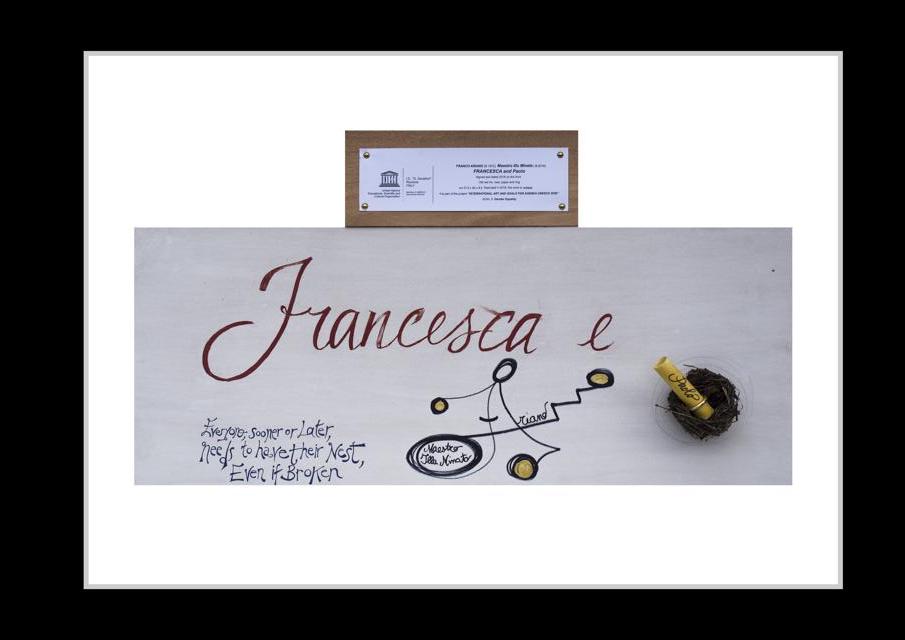
FRANCO ARIANO, always, observes problems by moving away from ”sequential logic”.
He resolves them by discarding obvious considerations, looking for alternative points of view.
Examples of his approach are the inventions of the ERECTUS grape and Wine, as well as the safe baby pushchair, which avoids the child facing the street, while crossing the road. Using Ariano’s system the handler is in front of the pushchair and no longer behind.
In this work, too, the artist becomes a “lateral thinking” interpreter.
Although new studies seemed to bring to light a new reality and facts other than those hitherto known, Ariano noticed that it has always been the norm for the male name to appear first followed by the female’s, as “Paolo and Francesca”. It is a custom throughout all societies and religions, to which many women have become accustomed. Thanks to a simple and brilliant inversion on the order of names, placing ”Francesca” first, the artist intends to compensate for the ”GENDER OFFENSE” suffered by women for over 800 years.
Francesca da Polenta, or Francesca da Rimini (Ravenna, 1259/1260 - Gradara, 1285), was the victim of an honour killing at the hands of her husband when she was young.
Francesca da Polenta and Paolo Malatesta are two symbols of love who became part of popular sentimental imagination, even though they also belonged to the world of history and literature.
A part of the V canto of the Divine Comedy by Dante Alighieri is dedicated to them. In the Divine Comedy, the two young people —Francesca from Rimini (she was born in Ravenna), and Paolo from Verucchio - represent the main souls condemned to Dante’s hell, in the lustful circle.
In life they were brother and sister-in-law (Francesca was in fact married to Giangiotto, Paolo’s brother) and this love led them to death at the hands of Francesca’s husband.
The work is intended to make people aware and understand the concepts of gender inequality and gender discrimination and to understand all forms of gender violence. For example, harmful practices such as female genital mutilation, honour killings and child brides, employment opportunities and unfair pay, traditional gender roles, impact on gender issues and to understand the current and historical causes of gender inequality.
MIRACQUOLO
Work inspired by goal # 6 OF AGENDA UNESCO 2030:
Ensure access to water and sanitation for all
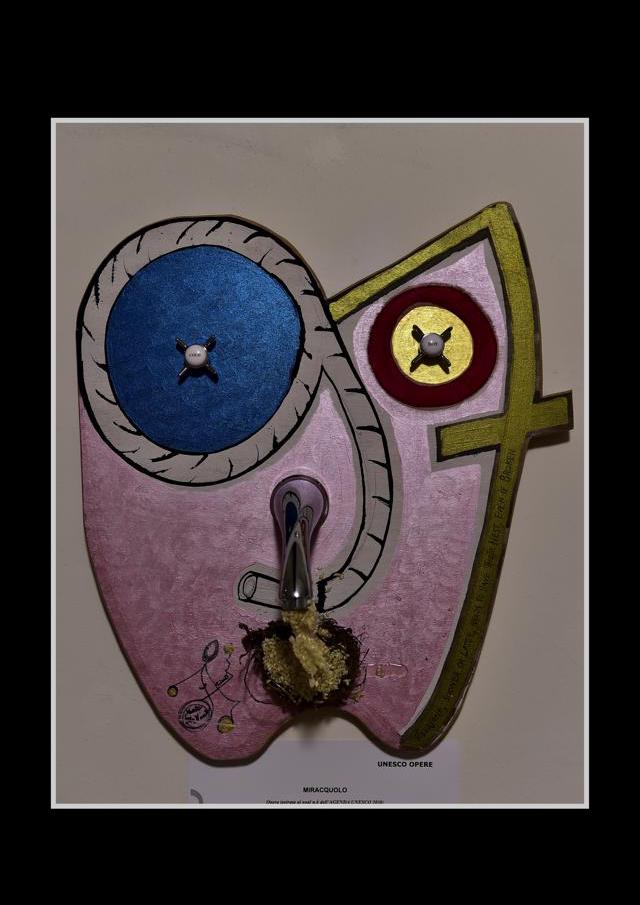
A real blessing is having a tap from which comes clean, drinkable water every day, the miracle of water is characterised by its rarity and we have become habituated to it, too quickly. But it is the same water that is used to clean the W.C. in our bathrooms. Reduction of waste and improvement of water management structures and processes will help achieve goal n.6.
This work is a wooden face in the shape of half an apple and the number 7.
The mouth is represented by a cracked pipe that loses a lot of water.
It should bring water from the reservoirs to our homes, but because of the serious state of the pipes, it loses more than 50%.
The eyes are the handles of taps and the nose is an anthropomorphic shaped tap. From the tap comes 3,400 grains of rice and when we observe the face we recognize the number 970.
All this reminds us that to produce one kilo of apples we use 970 litres of water and for a kilo of rice as many as 3,400 litres.
SPORT HAS NO HANDICAP
Work inspired by goal # 10 OF AGENDA UNESCO 2030:
Reduce inequality within and among countries
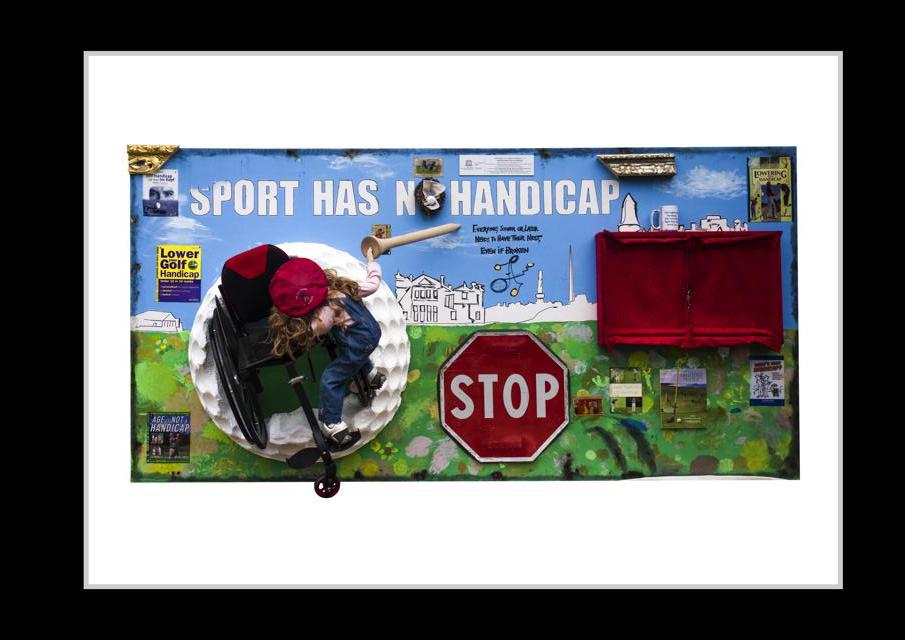
This work of art was made in collaboration with Fondazione Vertical and the designer Danilo Ragona (they have already paraded models in wheelchairs wearing clothes by the world’s greatest designers, in Dubai, New York and Milan).
This work intends to rethink the use of the term Handicap and the aim is to have it replaced in the sport of Golf.
This work is a large wooden panel which has as its setting the most prestigious golf course in the world, St. Andrew’s in Scotland. From the fairway a giant golf ball appears and it is BROKEN by the only carbon wheelchair in the world, built by Ragona in collaboration with Alfa Romeo. Suddenly a ceramic girl, who previously was unable to stand, but now thanks to research on nano technologies carried out by Fondazione Vertical, manages to overcome her disability and after climbing the big golf ball, puts a huge wooden ”T” under the word HANDICAP.
Ariano felt the need to produce this work of art after having successfully practiced the game of golf, as he felt it was terribly unfair and literally incorrect to use the term HANDICAP, (which in golf represents an ADVANTAGE, a number of shots more than professional players).The sentiment which was at the base of the work is widely shared by instructors and golfers of the Golf Federation, so much so that many professionals have encouraged Ariano to continue with the same tenacity in his cause to replace the word HANDICAP with another word.
On the right upper part of the panel is a little red theatre, whose role is to keep St.Andrew’s Castle hidden until the term HANDICAP is changed. When this happens it will be possible to ask the Senese notary Andrea Pacini for the key which will open the theatre curtains of the little red theatre. Once opened, it will be possible to admire the artist’s gift, thanking the many golf federations around the world.
Furthermore Ariano has placed an original ROLEX golf ball in one nest, with the aim of involving one of the biggest sponsors in the world in supporting this worthwhile project.
SVEGLIA - WAKE UP - ALARM CLOCK
Work inspired by goal # 2 OF AGENDA UNESCO 2030:
End hunger, achieve food safety and improved nutrition and promote sustainable agriculture
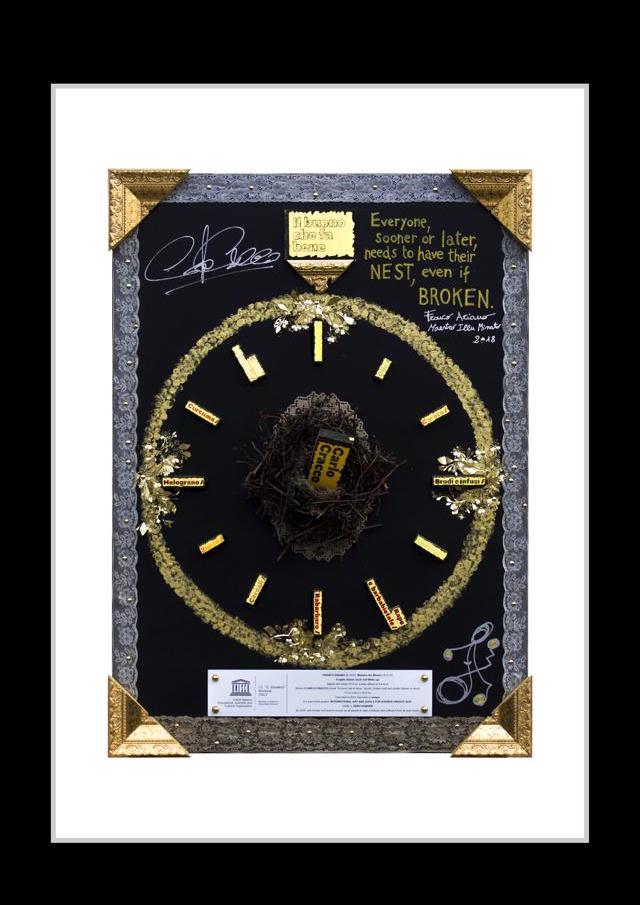
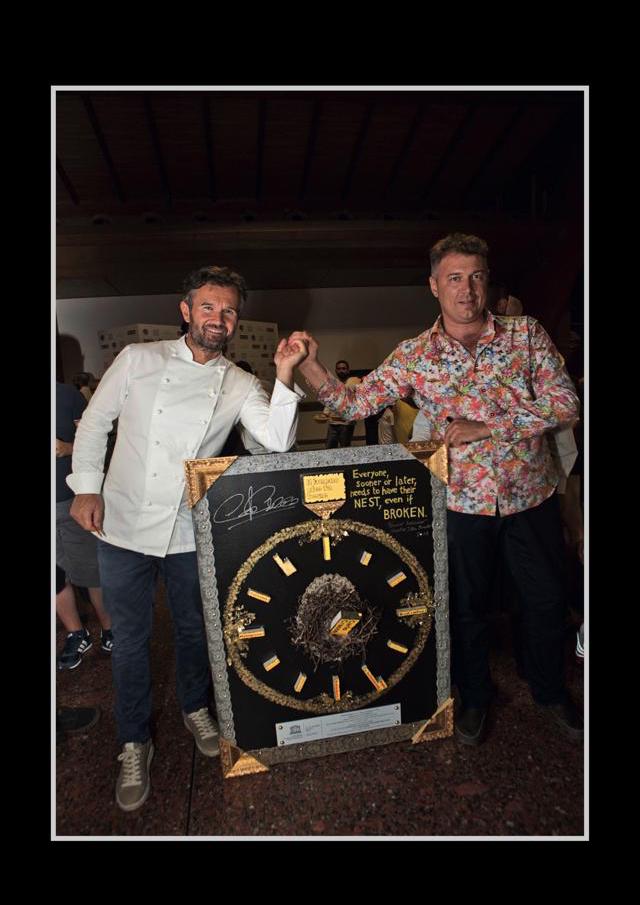
This work is a great clock created using real slices of Chef Carlo Cracco’s new book
“Il Buono che fa bene (”The Good that does good”)
Its aim is to enhance a great step forward made by the most important Italian chef in the culture of quality food for healthy eating.
Ariano noticed that there were exactly 12 chapters in the book and each one represented 12 healthy food items.
He immediately thought that a “Good” way to ”wake up” people was undeniably through a great ”ALARM CLOCK” that uses slices of Cracco’s cookery book for the 12 hours.
Ariano immediately thought that a ”good” way to ”change and wake up ” people was through a large alarm, thereby leading them to prefer better food.
The 12 hour-numbers of the Clock are made with 12 slices of the book.
Chef Cracco was enthusiastic about Ariano’s work and he signed his name in the upper left corner.
PENTITI - REPENT
Work inspired by goal # 15 OF AGENDA UNESCO 2030:
Sustainably manage forests, combat desertification, halt and reverse land degradation, halt biodiversity loss
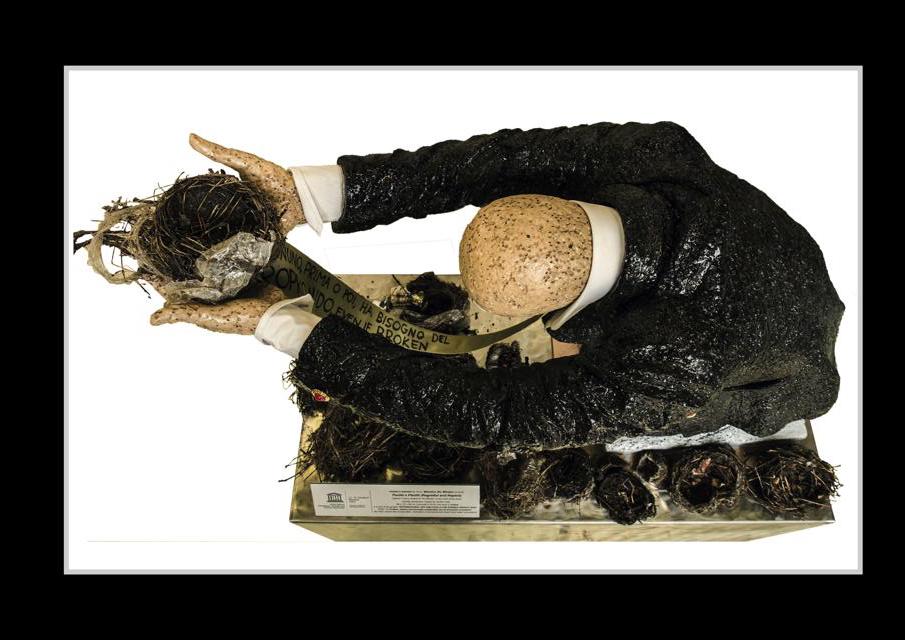
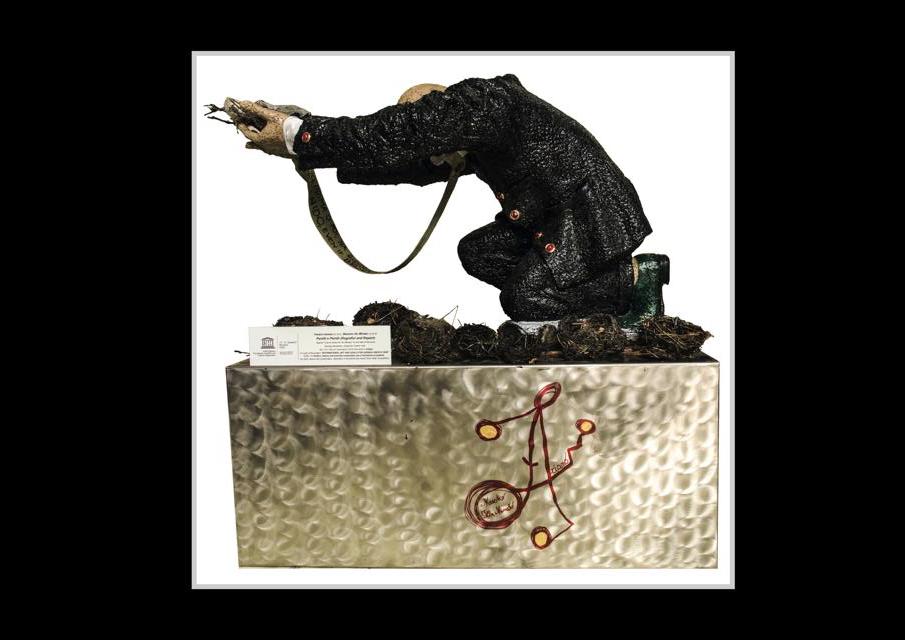
More recently, many are turning their attention to the problem of the seas in relation to the presence of plastics in the water. However, few have noticed the problem which exists in the air.
Ariano always signs his work with a real BROKEN Nest, one which has fallen and is no longer usable by birds (compliant to the law and in correspondence with the competent office of the Emilia Romagna Region). Foraging between scraps of pruned and fallen trees the artist has noticed that birds build their nests with lots of ”human” plastic.
It is a spongy “Gress” sculpture created in collaboration with Corsucci Umberto, MonteMaggiore Arte, Italy.
It depicts a ”contemporary” man, an important manager in a suit and tie who kneels symbolically to posterity, with arms outstretched, head bowed, holding a real BROKEN Nest comprising of numerous pieces of plastic.
Ariano placing the accent on the vowels of the word PENTITI, wants to identify 2 types of men.
The first type are the ”Pentìti” meaning those who “regret”, men who have accounted for the damage created to the environment by their inattention or even worse their bad faith.
They kneel apologetically ”having regretted” their actions, but ready to improve.
The second type are the men who still pretend that the problem does not exist or that, for their own personal interest, keep it hidden.
To these men Ariano says ”Pèntiti”, meaning “you have to regret”, an imperative that will serve to redeem them.
Both feel very lonely and in this work Ariano has dedicated this mythical phrase to them:
“Everyone, sooner or later, needs to have their nest, even if BROKEN”.
here engraved on the tie.
HOME
Work inspired by goal # 16 OF AGENDA UNESCO 2030:
Promote just, peaceful and inclusive societies

Ariano, like many, was shocked by the photo of the baby in a suitcase.
With this installation he wanted to replicate the drama of the child transported asleep, from his father, inside a suitcase, his new ”nest”, after the bombing of his house in Syria.
The child, symbol of the atrocities of the Syrian war, was represented by the artist with incomparable verisimilitude to the original photo.
Everyone who has seen the work has called it ”awesome”!
Some have asked to cover it.
OTHER WORKS
Franco Ariano Maestro Illu Minato
By September 2018, the only VIDEO-WORK created by Ariano was entitled:
”PAGE 45, THE STRENGTH OF A PAGE”
It was created using a video camera at 3 am. during the night of May 13th, 2017, when Ariano was reading a book by Francesco Bonami titled
“Lo potevo fare anch’io. Perché l’arte contemporanea è davvero arte”.
When Ariano arrived at page 45 he noticed that the page continued to return to the previous page even though he pushed it down repeatedly several times. He took the camera and filmed what was taking place. He wanted it to represent the strength of words, but also the importance of books, a theme dear to Ariano’s heart.
From this experience the work ”MEN WITHOUT PAPER” was also born
Other works by Ariano are
LUPIN & KAOS IN PACE, REJECTIONS A GO GO, PROFUMO DI FREDDO MILENA, CHRISTIE’S MUNDI, UOVO SEBASTIANO, RELIGIOUS LEAGUE, HOT ARTIST, TIMBERLAND, SQUISSING, VIEILLES VIGNE, ROMANEE CONTI, MASSETO 1986, CHATEAU CLOS VOUGEOT, BOUCHON, WHITE CUBE, VERNISSAGE, ISPNEIM, LETUS, MESCIU CHICCO, MIGRATORI, QUERCIA 58, PODIO DEGLI ULTIMI, IOPERAIO, HAPPYPI’, CRISTO SENZA CRISTO, LA NIDA, NASCONDINO A LUTRY, TUTTO MIO PICCOLO IO , IL CORPO DI CRISTO, TORRI DI PISA, VULVANO, FIORE DELLA FELICITA’, IL PRODOTTO SEI TU, VAX, SESSO PERDUTO, MANIERA, ARTICOLO QUINTO, PLOTONE, DOLORE PURO, OSCENE VIRTU’, TAPAS BARK, E NON CI SEI PIU’, VERGINETO Pesaro Urbino Italia, ATTI IMPURI, IN & OUT, SKY ARTE, SEDUTE SUDATE, PILLOWS, VIDEO : HAPPY VAN GOGH BY FRANCO ARIAN MAESTRO ILLU MINATO, OMAGGIO A PHILIPPE DAVERIO ILLU MINATO, SEND AN EMAIL, ULTIMA CAREZZA, PARENT LICENCE, HOTEL SPADARI MILANO, 19, QUADRATURA DEL CERCHIO, UNO SU QUATTRO, VITIS DOMINI, BIG KNIFE-LITTLE GIRL, OLISBOS, PADDINGTON, TACTACTIO PALLIS, GENOVA 2018, CARCIOFO GOLIARDIA, INFI, DONNA CINESE SEBASTIANA, MARE, 90 MLN YRS, FINO A 12 ANNI, LOVE, AMUSE BOUCHE, TIMBERLAND, MUNCH NEST, HRC, COCA LIGHT, GUARDANDO IL SOLE, REPUTATION, C’E o NON C’E ?, “WE” HUMAN DESIRE, NON E’ UN PIATTO DI, ALLO SPECCHIO, REAL FALSE, TATE, IPOSSIA, 0,618, BELLISSIMO ITALIANO, ERROR, CLIO DINAMICA, STAO MENTALE CONGELATO, WLF, DISUMANIZZAZIONE DEI GRUPPI, WITH or AGAINT ?, PARA BELLUM, CAPACI DI FARLO, BARBIE, SOFT POWER, PITAGORA IN LOVE, TWITTER, ENTROPIA, CUORETTO SPA RED CHIPS,
DISTANZA DI INSICUREZZA,
TINO CLASTIA (in sharp contrast with tino sehgal),
36’ KM,
JE NE SUIS PAS PICASSO - JE SUIS UN GENTILHOMME.
One of his works which he admires the most regards the relationship between humans and two dogs, Lupin and Kaos, recently deceased. The work was inspired by a sentence uttered by Lupin’s owner:
“For 14 years we were so close and shared every second of our life with him.
I feel it, I breathe it and my gaze still tries to find his if only to exchange even a simple “Hello, I’m here.” Believe me it is very difficult even to write these few lines”.
CRACCO
Franco Ariano Maestro Illu Minato
1) HAVE YOU REALLY BEEN TO CRACCO’S RESTAURANT?
2) WHAT WAS THE FOOD LIKE AT CRACCO’S?
3) HAVE YOU MET CRACCO?
Monday, October 16th, 2017, exactly 1 year and 1 day after his surgery, Ariano went to
Cracco’s restaurant, in via Victor Hugo No. 4, Milan.
Many restaurants, all over the world, had asked Ariano for a bottle of his wine Erectus, but Ariano decided that no retailer, agent, wine shop or restaurant could buy his wine ”directly”, in fact it is only to be sold through international auction houses, as was the case at Christie’s 2011, Geneva.
In a dream Ariano had dreamt of a meeting. The owner of Uovo DiVIno asked Carlo Cracco, the creator of the ”marinated egg”, to exhibit the marble container in his new restaurant in the Gallery in Milan.
The title of this chapter, in fact, consists of three titles and was chosen by Ariano because they were the questions all his friends had asked him on his return from the restaurant.
He phoned the day before going to the restaurant, and booked the last remaining table for dinner at 9,30.
Ariano’s aim was to explain to Cracco who he was and what he had done in the past in the wine world.
He knew that on Monday evening the chef, with all his commitments between the various restaurants, Hell’s kitchen and the design of the new gallery premises, certainly wouldn’t have been in the kitchen to direct the “Brigata”.
Ariano had however prepared his speech and had with him the CHRISTIE’S catalogue for the 2011 auction, photos of the articles on VINO ERECTUS, and a fully charged phone-battery, to show the new photos of Uovo DiVino exhibited at the Triennale.
9 pm. At the Duomo in Milan, Ariano met his friend Incognito, Mister ”V”, to whom he had asked to accompany him. The two, after a quick look in the Gallery to see the progress of the work on Cracco’s new restaurant, arrived in via Victor Hugo No. 4.
A well-dressed young man opened the door and checked their reservation.
All was confirmed. He showed them to their table downstairs.
While going down the stairs Ariano noticed that, among the ready to serve bottles of wine, was also a Dugat-Py, one of his oenological myths. Ariano and his wife Milena had personally met Bernard Dugat and Jocelyne Py about 10 years earlier on one of his travel-researches in Burgundy.
The Burgundy vintners had warmly welcomed them and Bernard had even given Ariano a signed bottle of Chambertin. Ariano, from a distance was looking to see if, the bottle was a Gevrey Chambertin, Mazis Chambertin or a charmes Chambertin. However, any of these wines would be “perfect to start”.
A serene atmosphere, style and elegance, but zero austerity, especially from the kitchen.
He noticed that the average age of the waiters was strangely low compared to what he would have imagined. The sommelier was no exception.
Water was offered first, together with the food menu.
They had decided to focus on the “full food tasting”. Great choice.
Immediately after, they brought the wine list, a tome, a rich encyclopedia of wines, composed of well-organized pages of Italian and international wine-producing areas.
The prices of course were stellar with some Romanee Conti, as usual above 20,000 euro each.
Ariano read the food menu, he liked almost everything except for one thing.
Cracco’s Russian salad. ”I’m going to taste everything on the menu, but that’s a no thank you.
How is it possible, I’m at Cracco’s, It’s going to cost me an arm and a leg and I have to eat Russian salad??? He can eat the salad”.(oops, I shouldn’t write this, but it was the reality)
The tasting began and for 50 minutes they ate without any cutlery on the table, so at one point Ariano asked the girl: ”excuse me, but maybe you forgot to bring the cutlery?”
She replied ”No, this is the Finger Food stage and you eat with your fingers, but if the gentlemen would like cutlery we can bring it right away”.
After the Finger Food stage, the cutlery arrived and they continued with the food tasting and the previously chosen wines, which were served and replenished continually and seamlessly, unlike any other place they had ever been. At a certain point, between one glass and another, Ariano saw in the distance, in the small room in front of him, a chef, with his back to him, half hidden behind a column. The chef standing tall and straight was joking and laughing with a gentleman sitting at the table. They were both being very sociable.
”It looks like him, yes, yes, tell me it’s him, it’s Cracco”.
But then he realized that it was a young man dressed as a chef, who had probably gone to greet the customers and their children, it wasn’t Cracco.
”Not that I thought it would be him, but for a few seconds I thought it might be”
Unfortunately the chef went back into the kitchen.
The delights of the menu continued at an extraordinary high level and were in harmony with what had already been served. Studied, perfect combinations, daring, incredibly striking contrasts elevating “Cracco, to a whole new planet”, which is the title of another work of art by Ariano.
A fundamental question came to Ariano, the question everyone asks, the same question asked of Damien Hirst by a journalist in Venice:
”Damien, What’s Art?”.
Hirst said: ”Fuck knows!?”.
Everyone has their own definition of art and even Ariano up to that point had his own.
Ariano understood:
”Today I know exactly what it is. It is the ability of the soul to fly beyond Borders”.
Without realizing they found themselves forgetting about time and space. The standard of the restaurant was of the highest quality but not too formal; intelligent and attractive dishes, sometimes difficult to understand due to the desired effect and the obtained perfection.
”I eat, I feed, but my mind is the beneficiary, my horizons have shifted. This is the work of a great Italian man, a model to be taken as a reference in terms of ingenuity and personality. Dear Carlo, I would like to bring the dearest person in my life to your restaurant my 8 years old son Benjamin, because he must see that there is a place like this”.
After 2 hours had passed very quickly, Ariano heard a voice coming from the same little room as before, probably from a television on the back wall.
”I know that voice, I have heard it hundreds of times on television during MasterChef and Hell’s Kitchen. It’s him, it’s really him, but the voice was coming from the television”.
At that point Ariano asked the waitress, ”excuse me, but is that Cracco on the television?”
She replied, ”No the Chef is in the kitchen”.
Ariano told her how he would like to describe his project to the Chef and asked if it was possible to speak with him”.
The waitress went into the kitchen to ask.
Ariano realized that he hadn’t been to bathroom for some time, in fact before entering the restaurant, for many reasons he had continued drinking without interruption.
As a result, he could no longer resist.
As he waited for the girl’s return, with a yes or no, he decided to go to the bathroom and moved his chair to get up.
But in that restaurant when you move the chair, a waiter immediately helps you and accompanies you to the W.C.. Ariano said ”No problem, I can go alone”, but the waiter kindly said that their practice was to accompany the customers.
The two went off, the waiter waited outside and Ariano went in.
In the bathroom there was a large mirror, Ariano looked at his face, a thousand thoughts passed through his mind, “Will Cracco accept my invitation or not?”
He washed and dried his hands and was escorted back to the table.
Mister ”V”, Ariano’s friend, remained at the table and on his return said that the waitress had returned with a YES. The hairs on the back of his neck stood up and for the first time in his life he also felt the hairs on his thighs rising. Later Ariano would explain his project.
But there was a problem, Ariano had gone to the bathroom, but had forgotten to do what he had gone there to do. He had only washed his hands.
He continued to drink and was full to bursting, he moved the chair a second time and the waiter looked at him strangely. Ariano said ”No comment, I must go back up”.
”Same procedure with the desired result”.
”When I think of a dinner that lasts almost three hours, the word ”boredom” comes to mind, a stiff butt and the desire to get up. Not here. The attention to detail and friendliness make the time pass very enjoyably.
“Has this place got a flaw?”
”Yes, one. It ended too quickly and I would have liked to have experienced, more and more, again and again, so much so that if they asked me to start again, I would say, Yes right away!”
30 minutes after midnight. The dinner ended. Cracco finally invited Ariano to the kitchen for the meeting.
Mister ”V” advised Ariano ”Don’t upset him or make him angry, don’t …, don’t…”
Ariano replied ”I just want to tell him, without exaggerating and pleading, why I am here”.
Looking each other in the eye Cracco and Ariano finally greeted each other with a strong handshake, under the gaze of the entire staff.
Those eyes, that thanks to the TV screen, even before words were spoken, Ariano had learned to read.
Self-confident and decisive eyes, but at the same time Ariano could see slight fatigue,
in fact it was already one in the morning.
Now those eyes were there in front of him, busily appraising this person facing him.
Under scrutiny but not under the pressure Ariano had imagined, incredibly speaking about VINO ERECTUS with Cracco had put him at ease.
It was a meeting of equals.
He explained that this wine, with all its particularities, would allow it to be drunk in future millennia.
Moreover it was obtained from erectus clusters, grown in a vertical position until their harvest.
Cracco was impressed when he understood that the wine was the only one in the world sealed with 2 corks. In order to close his bottles Ariano had been to Switzerland, where a specialized company had modified an old manual machine used in the past to close Champagne bottles.
For the first 4 vintages (2009, 2010, 2011, 2012) all the apparatuses and accessories needed to conserve the ERECTUS Bottle are kept inside the Erectus metal-safe-box.
For the last vintage, 2015, they are inside the Uovo DiVino.
Cracco’s taste buds and curiosity had been awoken and like everyone else, wanted to taste all these beautiful words of wine. ”Let’s taste this VINO ERECTUS 2015” he said.
Embarrassed, Ariano answered ”NO”.
And Cracco: “Why NOT?”
”It is not technically possible, not that I don’t want to, but it is the only wine made, not to be drunk. It was produced in the understanding that it will be handed down over the centuries, that’s why I want to exhibit it in your magnificent cellar in the most important restaurant in the world”.
Ariano confessed that the idea had come to him in a dream, probably due to their common passion on the themes of the ”Egg” and ”Wine”.
“If this is how I felt in the Victor Hugo restaurant, I can’t imagine what experiences await me in the new restaurant in the Galleria of Milan”.
Ariano concluded with a thought:
“My heart isn’t beating fast, I’m not red in the face, I’m not sweating, I’m just, very, very happy, like the kid who has found his mom after losing her. I think I weigh a lot more than when I arrived, because HAPPINESS in this “planet”, is so heavy that you need to measure it in kilograms ”
P.S. 1: Cracco’s response to Ariano’s proposal was: “YES”.
P.S. 2: The Russian salad, incredibly, was the dish Ariano liked the best, an extraordinary, formidable culinary intrigue.
P.S. 3: HOW MUCH IS AN ARM AND A LEG AT CRACCO’S?
At the beginning the bill could seem an enormous amount, but for the quality it was very little.
It will be the future object of another work by FRANCO ARIANO Maestro Illu Minato.
VINO ERECTUS
Franco Ariano Maestro Illu Minato
ORIGIN VINEYARD
In the early 21th century, thanks to the remarkable insight of the artist-inventor FRANCO ARIANO, a cutting-edge wine experiment was launched: its results could completely change the physiology of the vine and the scientific basis known up to present day.
After participating in some private viticulture lessons with Dr. Ruggero Mazzilli in Tuscany (ISVEA), ”Respect for the verticality request of the vascular structure of the vine”, Ariano went back to the vineyard and started to look at his plants with a different point of view: they were asking for respect with regard to their vascular structure.
As you can see observing the birth stage of the clusters, in most cases they are born upright. Later, as their weight increases these clusters face downwards.
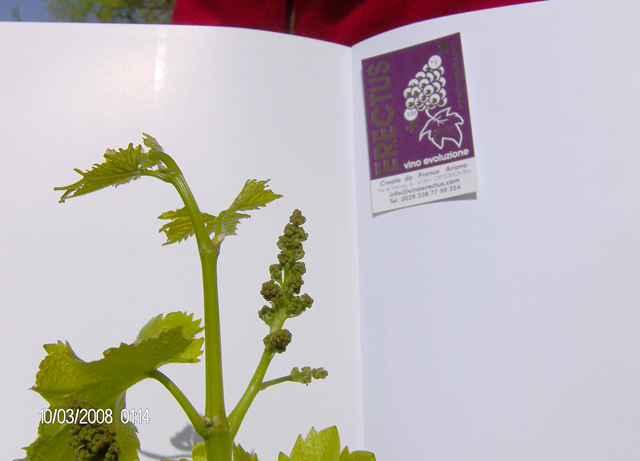
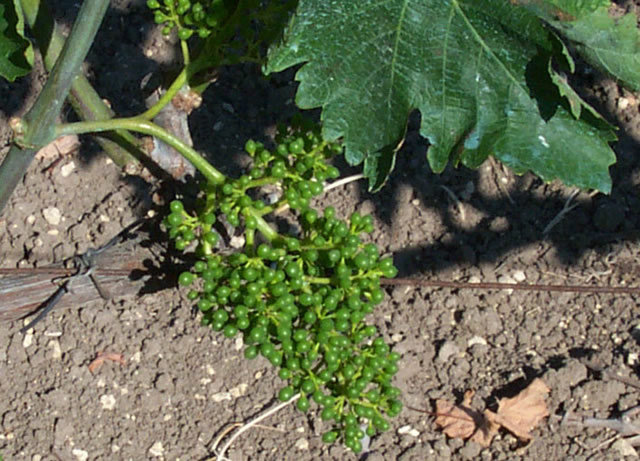
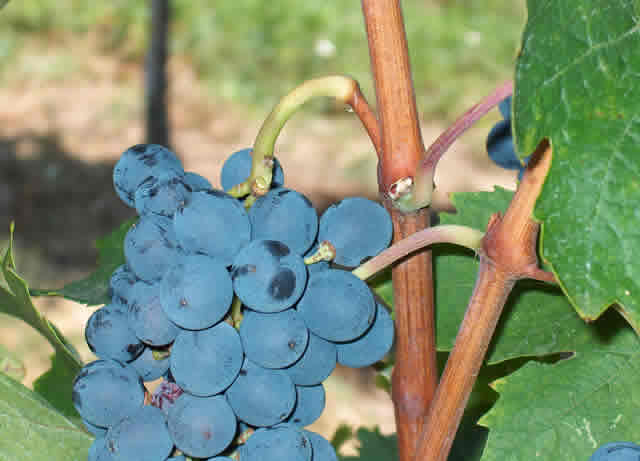
The curvature point of the rachis, combined with internal vascular depression, hinder the smooth circulation and exchange of lymph between the plant and the bunch.
The vine-grower has always respected the need for verticality, by attaching a picket at the trunk of the plant and at its bunches; but, subsequently, the bunches, due to gravity, face downwards towards the ground, and they rot together with their clusters.
From that moment, the various canopy management systems were born (cordone, Guyot, sapling, pergola, etc ...).
Then, to FRANCO ARIANO it was completely normal to close the loop of the vine, at the same time, respecting the need for the most important part of the vine, the CLUSTER, to be in a vertical position.
ORIGIN OF VINO ERECTUS
In collaboration with the Experimental Station for Viticulture (www.spevis.it) and ISVEA laboratories, Poggibonsi. In order to compare the characteristics of the grapes and the wines originating from traditional farming systems with those obtained by the ”ERECTUS” method, two pilot projects were launched in 2007, in two very important locations for their wine production:
San Gimignano and Gaiole in Chianti (Vertine).
“From the comparison of the analytical profiles of different thesis, it is immediately clear that the ERECTUS grapes have, in contrast with traditional thesis, a more balanced pH, a slightly moderated total acidity, a higher concentration of sugar, supported by a more complex acid environment and a stronger phenolic richness, both in terms of total polyphenols and anthocyanins, which are considerably more extractable.
These features are reproduced in the wines, which are more balanced, rounded and more colourful than the traditional thesis; their colour is more stable over time, thanks to a higher concentration of tannins”.
Following the last experimentation, the true Vino ERECTUS was created in 2009. In collaboration with some of the most important wine companies in Italy the 2009, 2010, 2011, 2012, 2015 harvest campaigns were organized.
The wines were then produced following a precise, rigid production system:
- manual selection of each grape with scrutiny under three magnifying lamps;
- fermentation in special pharmaceutical glass amphorae;
- manual soft pressing;
- bottling in bottles using the two corks system:
the first a synthetic cork, the second is used as an
oxygen reserve for aging;
- aging in special Safes or in “Uovo DiVino”, made of Carrara marble.
These procedures ensure the best conditions for humidity, temperature, absence of light, noise and vibration, safeguarding ERECTUS for centuries to come.
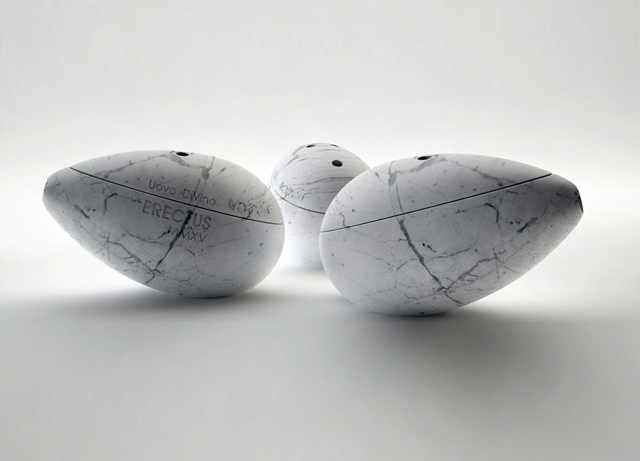
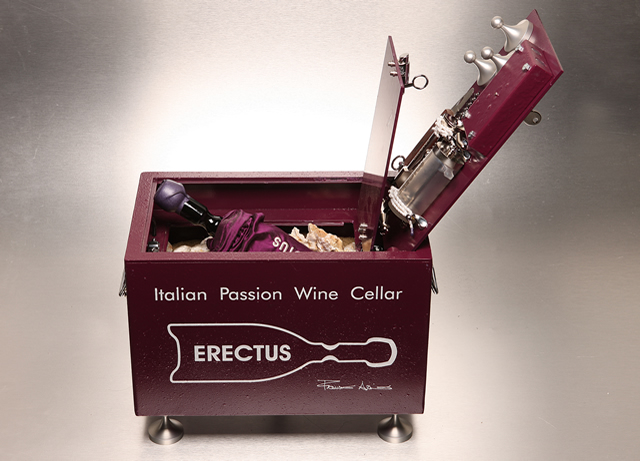
MISSION VINO ERECTUS
The economic value of a bottle of wine depends on its future.
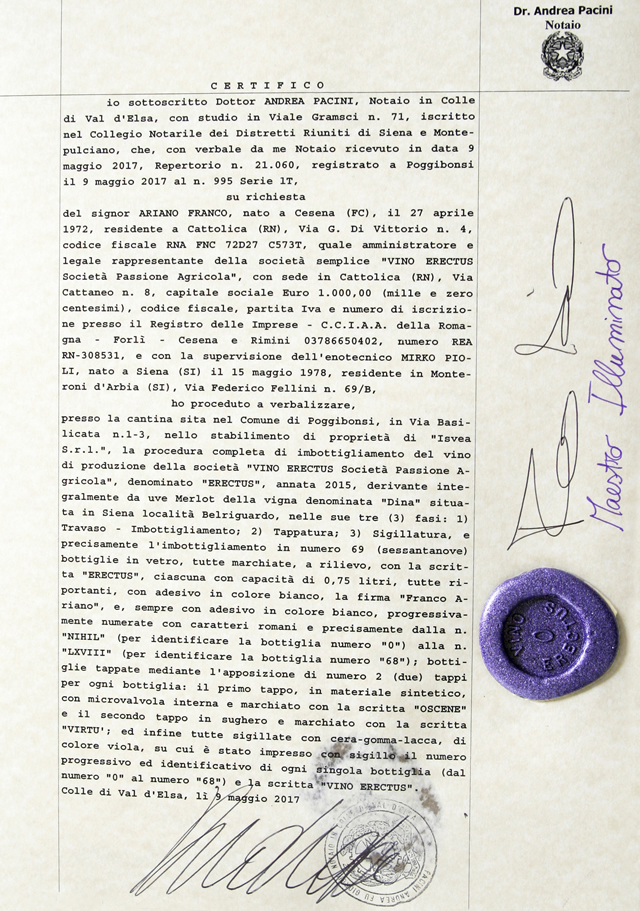
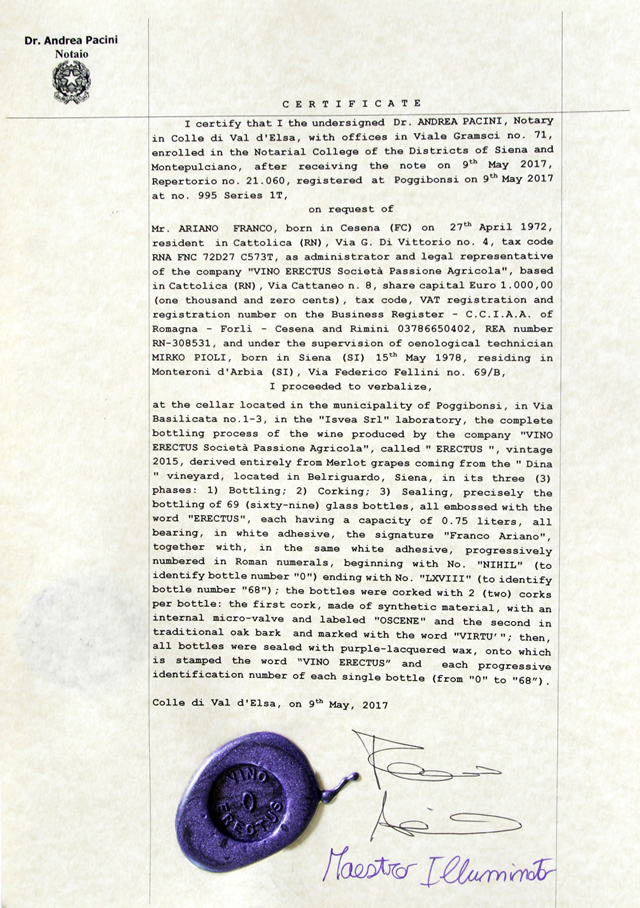
Vino ERECTUS is the only wine, created, protected and cared for, from its moment of birth, made to last for thousands of years.
Just as in the past artists were called to court, today FRANCO ARIANO is invited by the best winemakers to use, in small areas of their vineyards, his innovative method, through which grapes are elevated.
How did he do it?
1) Without any concern to cost, the total rejection of any quality price compromise, preferring, always and only, quality at any cost with no limit to expense.
2) Having the procedure certified by a solicitor in Siena.
3) Only making wine vintages when the quality of the grape is perfect.
4) Creating only 51 bottles per year, from the number zero to number fifty.
5) Choosing the best plants from the best vineyards.
6) Patenting a system which maintains the bunches of grapes in an upright position until
harvesting, obtaining healthier, untreated grapes, of a superior quality.
7) Guaranteeing quality in the cellar thanks to the collaboration of ISVEA laboratory professionals.
8) Inventing the first bottle with 2 corks, the first a synthetic cork with a micro-valve in contact
with the wine, the second, as a reserve for oxygen and aging.
9) Safeguarding every single bottle within a special cellar-container as:
Special safes & Uovo DiVino
Special metal safes accommodate individual encased bottles of the 2009, 2010, 2011, 2012 vintages. Designed to meet the best preservation conditions using special hydraulic and mechanical devices, designed to solve the 5 problems of wine; to guarantee it over the centuries, ideal conditions of humidity, temperature, absence of light, noise and vibration.
Uovo DiVino vintage MMXV - 2015,
Thanks to the architect Mario Bellini whose interest and collaboration helped to create, in Carrara marble, the smallest and most valuable wine cellar in the world. Each Uovo DiVino contains the relative numbered ERECTUS bottle that is subsequently covered with transparent resin together with the seeds. In this way the vintage MMXV - 2015 will be the only wine believed to have been passed down over thousands of years along with the DNA of the plant that it originated from.
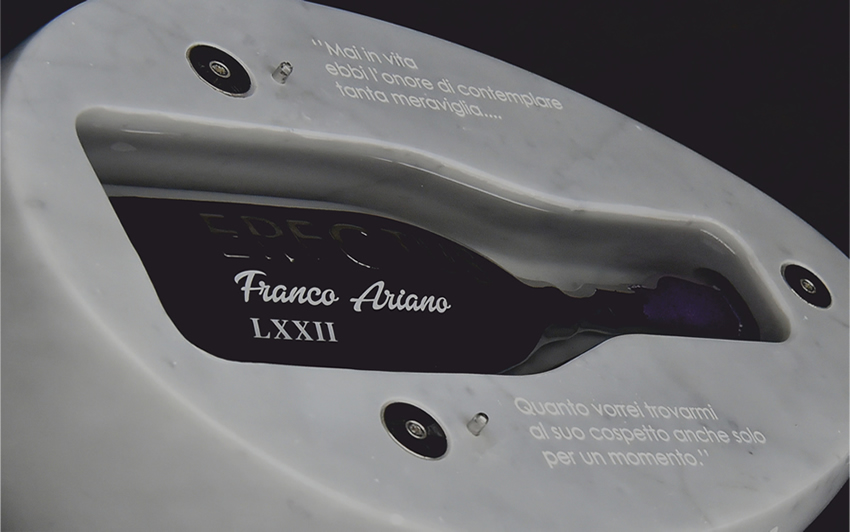
A true act of altruism towards posterity.
10) Making it impossible to even imagine the cloning of the bottle, the safe or the Uovo DiVino.
FRANCO ARIANO, HIS WINE AND VITICULTURE EXPERIENCE
FRANCO ARIANO, an expert in viticulture and a connoisseur of important bottles of wine, is an attentive observer, always ready to experiment and improve on well-known techniques. His endless curiosity, determination, skills and creativity accompany him throughout his never-ending study on the history of vineyards and its greatest masters (the most important being Dr. Ruggero Mazzilli), observing and visiting wineries all over the globe.
First of all, he decided to collect the most important bottles of wine in the world, choosing among those selected by Wine Spectator as the ”12 best of the 20th century” :
• Chateau Margaux 1900, • Chateau Mouton Rothschild 1945, • Chateau Petrus 1961, • Penfolds Grange Hermitage 1955, • Chateau Cheval Blanc 1947, • Domaine de la Romanée-Conti Romanèe-Conti 1937, • Chateau d’Yquem 1921, • Quinta do Naval Vintage Port Nacional 1931, • Inglenook Cabernet Sauvignon Napa Valley 1941, • Paul Jaboulet Ainè Hermitage La Chapelle 1961, • Heitz Cabernet Napa Valley Martha’s Vineyard 1974, • Brunello di Montalcino Riserva Biondi Santi 1955.
Seven years later, he had managed, to acquire 10 out of those 12 bottles, in addition to thousands of other less important bottles. The two missing ones were the 1931 Quinta do Naval Nacional Vintage Port and the 1941 Inglenook Cabernet Sauvignon Napa Valley. Interestingly, when he finally had the chance to purchase them, he decided not to, as there were suspicions about their authenticity.
He was thrilled to have collected those 10 bottles, together with the 1945 Romanèe-Conti and Chambertin Dugat PY. But even if he adores these masterpieces, he has only one aim: “to measure himself alongside them!”. He is certain that he will be able to do even better thanks to his knowledge and determination.
His ambition is to create the greatest, most important wine ever produced.
He is perfectly aware of the fundamental details in reaching his goal and understands the mistakes to avoid.
Ariano analyzed the weaknesses of those “mythical” bottles.
The first real problem is the contact between the wine and cork. In fact, a liquid, rich in acids reacts when it comes into contact with organic material over a long period of time and will lead to the total degradation of the compound after only 100 years or less.
Other shortcomings include the lack of attention to the bottle during transportation and the fact that the future owners will be free to make decisions regarding the quality and method of bottle preservation.
Furthermore, the lack of anti-fraud systems has resulted in the cloning of many bottles, which are then sold as originals.
Having created the best method of cluster growing, facing upwards to improve their ventilation, health and lymphatic circulation in order to obtain the highest quality, even this was not good enough for him.
He designed a new bottle with two corks: the first, which is synthetic, has a micro valve which lets the oxygen molecule pass and prevents the TCA (trichloroanisole) from entering; while the second cork used as an oxygen reserve for aging, was still not sufficient to satisfy him.
He improved the prior well-known technique burying the ERECTUS bottle in a mixture of soil and ash, inside specially built safes with a natural hydraulic system.
For the first 4 vintages 2009, 2010, 2011 and 2012, he invented the ERECTUS safe that not only preserves the only wine in the world made from ERECTUS grapes, but contains the necessary instruments to manage the wine, i.e. the ERECTUS brass corkscrew, made in Pordenone, which is the only tool capable of extracting the two corks; a syringe for the hydraulic system, at the bottom of the safe box; anti-vibration feet and a brush-knife to perfectly remove the wax-rubber lacquer. The safe box invented by Ariano has become the optimum system to ensure compliance with the aging criteria:
perfect humidity, constant temperature and absence of vibration, light and noise.
It was officially recognized at the Christie’s auction in Geneva, on 17th May 2011.
The wine is the highest ever priced wine, amongst first vintages (2009).
”The first wine in history, the mythical ERECTUS (2009) ....” to reach $7,826!
In 2015, still not completely satisfied with his achievement, Ariano tried to store wine in wooden, steel, golden and marble bottles, however the outcome was that glass still resulted in being the best material up to present day.
It was at that moment that Ariano had an intuitive idea, which was inspired by the discovery of grape seeds, skins and dried residues of wine, found by chance in ancient amphorae surviving from recent excavations on the island of Elba.
Ariano’s ambition was to create an immortal wine, a wine that can be passed down from generation to generation, the only wine together with its seeds.
Thus, starting from the vintage year MMXV - 2015, Ariano decided that he would transfer the wine from the safe to a new container made of Carrara marble.
In that area he discovered a river which lies at the foot of a mountain from which some splendid marble stones regularly and naturally fall to the river below.
He started collecting these marble stones by hand only selecting those that had a suitable shape capable of holding the ERECTUS bottle to be placed inside, together with the grape seeds that gave birth to the wine.
Later he went to the leading expert on anti UV transparent resin in Belluno. He poured the resin on both the bottle and the seeds contained inside the marble stone and by doing so he almost created the perfect cellar.
Nonetheless he was still dissatisfied with the shape of that magnificent stone.
Therefore he sought the advice of the Milanese architect Mario Bellini, who had recently designed part of the LOUVRE (twenty-three years after the opening of the pyramid designed by Ieoh Ming Pei) and whose second and final contemporary architectonical work is the new department of Islamic Arts made in the Cour Visconti, a seven year long project.
Mario Bellini was enthusiastic about Ariano’s project, and after 11 months, he had created and signed the ”Uovo DiVino”, the smallest and most precious wine cellar in the world designed solely to accompany throughout the millennia Vino ERECTUS.
A future vintage will be produced with ERECTUS clusters of vines cultivated at the foot of Mount Etna with the collaboration of the company “....”, weather conditions permitting. Ariano’s motto has always been:
“If there is a way to do it better, find it !”
MARIO BELLINI
Franco Ariano Maestro Illu Minato
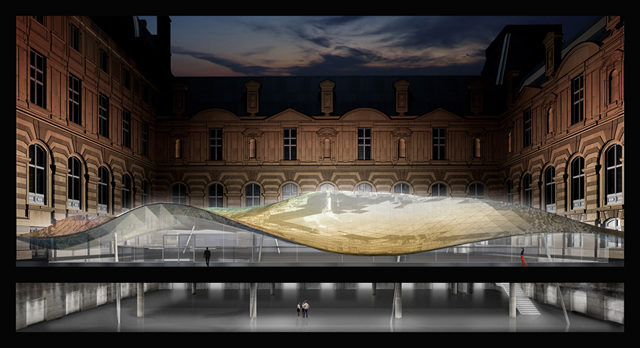
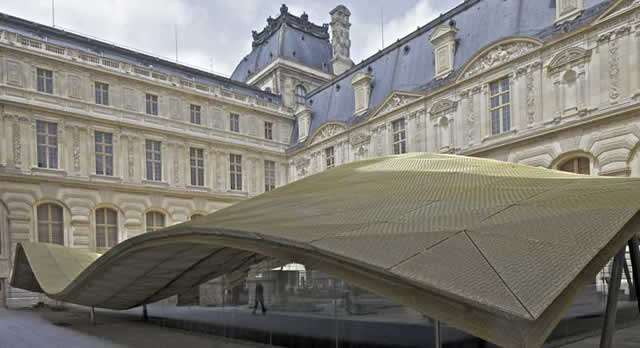
Still, filled with passion, in 2016 he worked closely with Mario Bellini from Milan, an Italian Archistar known for the following prizes:
- in 1962 he won the 1st prize “Golden Compass” with minimalistic
ante litteram table Cartesius.- He won 8 “Golden Compass”, the only architect to have done so.
- In 1965 he was the first person ever to design a Personal Computer for Olivetti.
- In 1972 he invented “Kar-a-sutra”, a mobile human space, for MoMA in New York.
- In 1981 Steve Jobs was present at Mario Bellini’s lecture
at International Design Conference in Aspen, Colorado. Jobs later wrote in his autobiography that he had tried to persuade Bellini, on more than one occasion, to join him at Apple, even twice going to his studio in Milan, but Bellini never took him up on his offer.
- He has 25 permanent “works of art” at the MoMA.
- He has designed numerous buildings around the
world, USA, Australia etc..
- In 2012, after having worked for seven years, he inaugurated, the Islamic art department at the LOUVRE, which is the second and last contemporary building within the LOUVRE,
Paris, following the majestic Ieoh Ming Pei Pyramid.
- In 2015 for the first time ever, at the Palazzo Reale, he displayed Giotto’s masterpieces staging an outstanding and revolutionary exhibition.
- In 2015 he received the “Golden medal award to Italian Architecture”
- In 2016 by invitation of FRANCO ARIANO, Bellini created the “Uovo DiVino”, the smallest and most
valuable wine cellar in the world, in Carrara marble.
- In 2017 Bellini is going to open the “Antiquarium forense” next to the Coloseum in Rome, narrating the history of the origins of ancient
Rome.
- In 2017 the Triennale of Milan awarded Bellini, the world renown Milanese architect, an exhibition of his entire work entitled “Mario Bellini. Italian Beauty” taking place exactly 30 years
after Bellini’s 1987 MoMA exhibition, where 25 of his works had been on permanent display in the museum.
In 2016 together Ariano and Bellini designed Uovo DiVino for Vino ERECTUS MMXV 2015, which is objectively the most precious wine in the world and throughout history, the only wine obtained
from erect clusters, protected inside “Uovo DiVino”, in Carrara marble. Each Uovo DiVino contains the relative numbered ERECTUS bottle that is subsequently covered with transparent resin together with the seeds.
In this way the vintage MMXV - 2015 will be the only wine believed to be passed down over thousands of years along with the DNA of the plant that it originated from.
Each bottle is closed with 2 corks.
Uovo
DiVino n.1 has been given to CHRISTIE’S with a fixed starting price of 100.000 euros.Only 69 bottles exist, numbered from 0 to 68. Each bottle is accompanied by its individual progressively numbered certificate
by notary Pacini Andrea of Siena.
It is a true masterpiece of Italian genius and style. We have officially been invited by the Milan Triennale to present it at the “Mario Bellini - Italian Beauty”
exhibition.
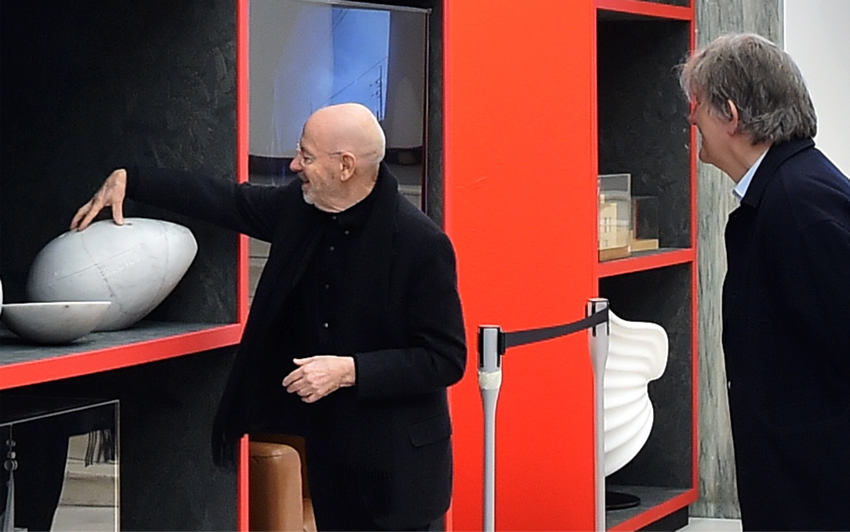
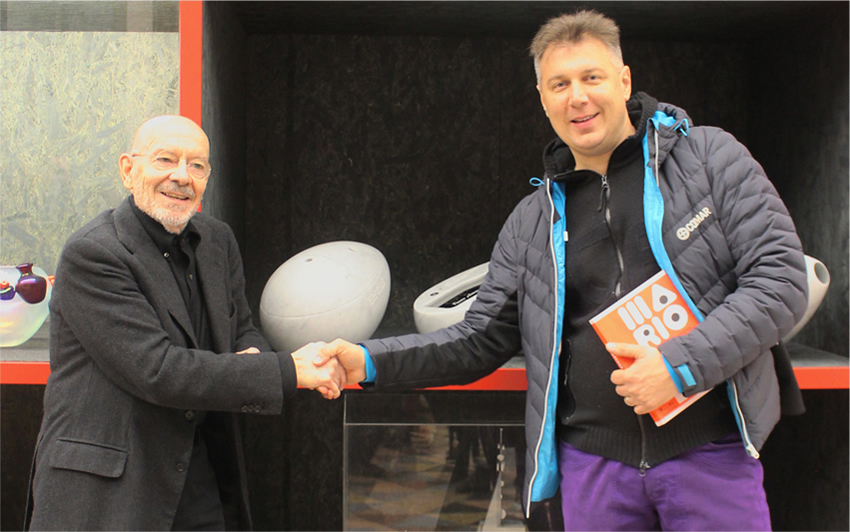
“Aspiration to Universality and Memory of the World
Become
a true act of altruism towards posterity”.